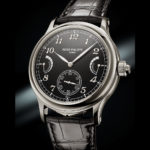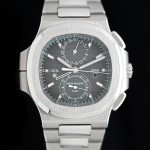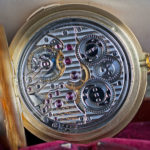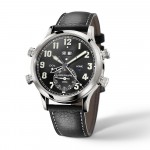In-Depth: Patek Philippe Grande Sonnerie Ref. 6301P-001
Magnificent and grand.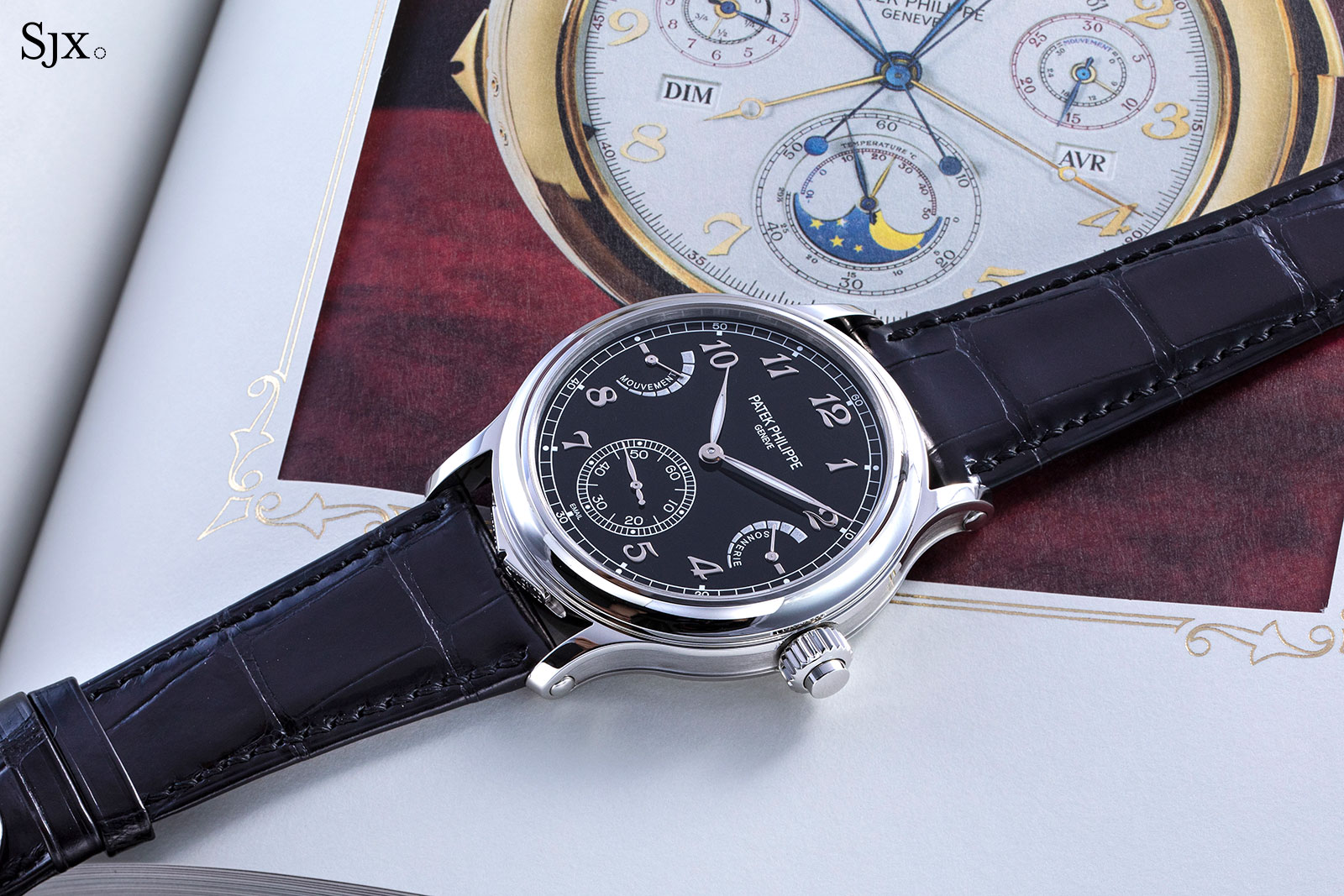
Patek Philippe closed 2020 in a big way with the launch of the Grande Sonnerie ref. 6301P-001 in November. The most complicated wristwatch unveiled by the Geneva watchmaker in recent years, the Grande Sonnerie is a grande and petite sonnerie carillon.
With last year’s Geneva watch fair cancelled, the brand unveiled its new releases one by one throughout the year, starting with the limited-edition Calatrava ref. 6007A in June, allowing each new model to be in stores as soon as it was announced. The Grande Sonnerie ref. 6301P-001 was no different, albeit on a tiny scale, with reputedly only a handful available in each region – all sold before the launch.
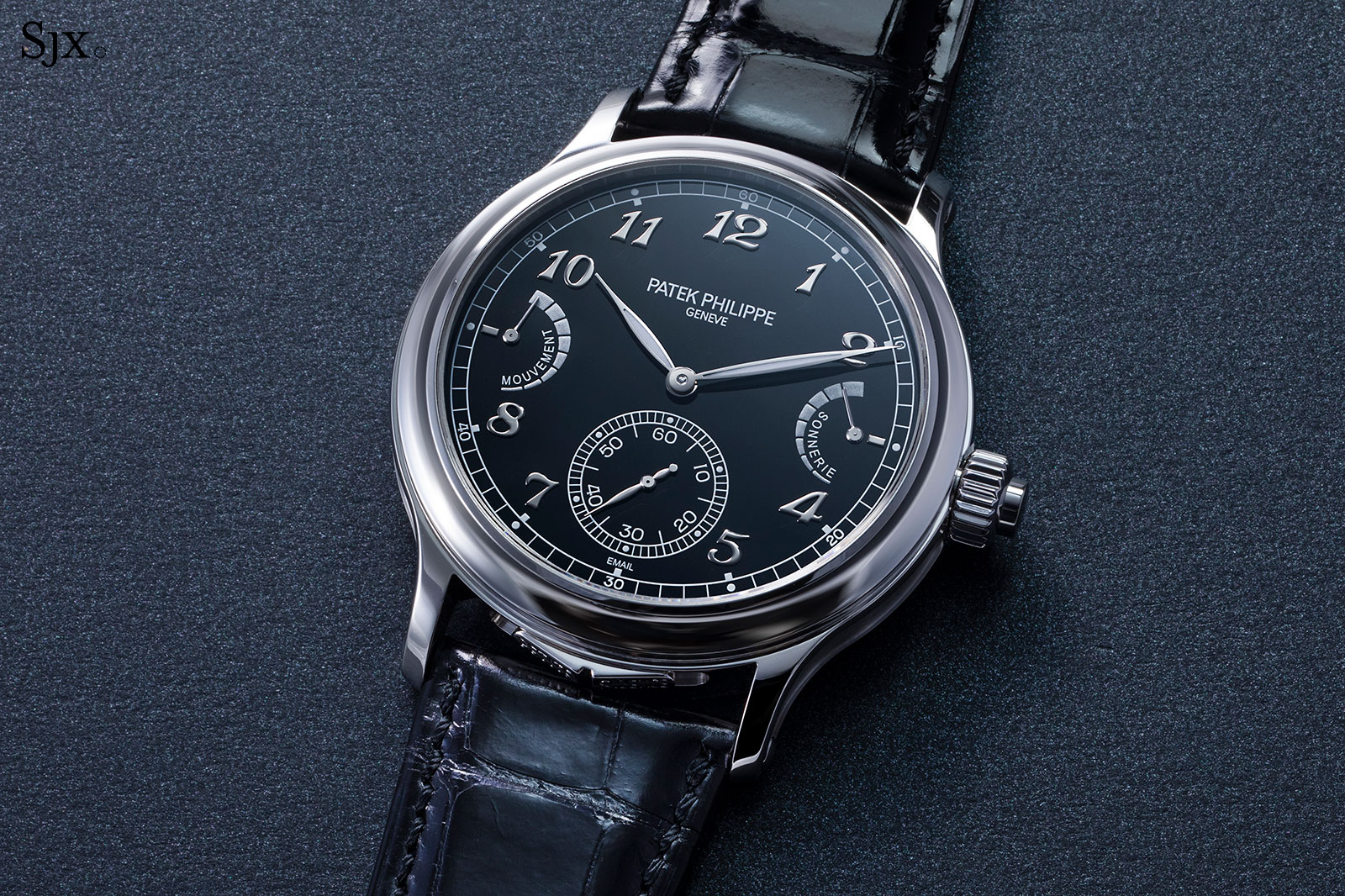
Initial thoughts
An impressively large watch, the ref. 6301P feels like a modern-day grand complication. The size is a consequence of the wide and complex movement, so the watch has good proportions all things considered. But the styling is classical, incorporating many elements from vintage Patek Philippe watches – and also the ref. 5370P split-seconds chronograph – which gives it an elegant appearance, something helped by the relative thinness of the case.
Still, it is clearly a contemporary watch – Patek Philippe rarely does exact remakes of vintage watches – with details that mark it out as such, including the recessed case band and the luminous hands.
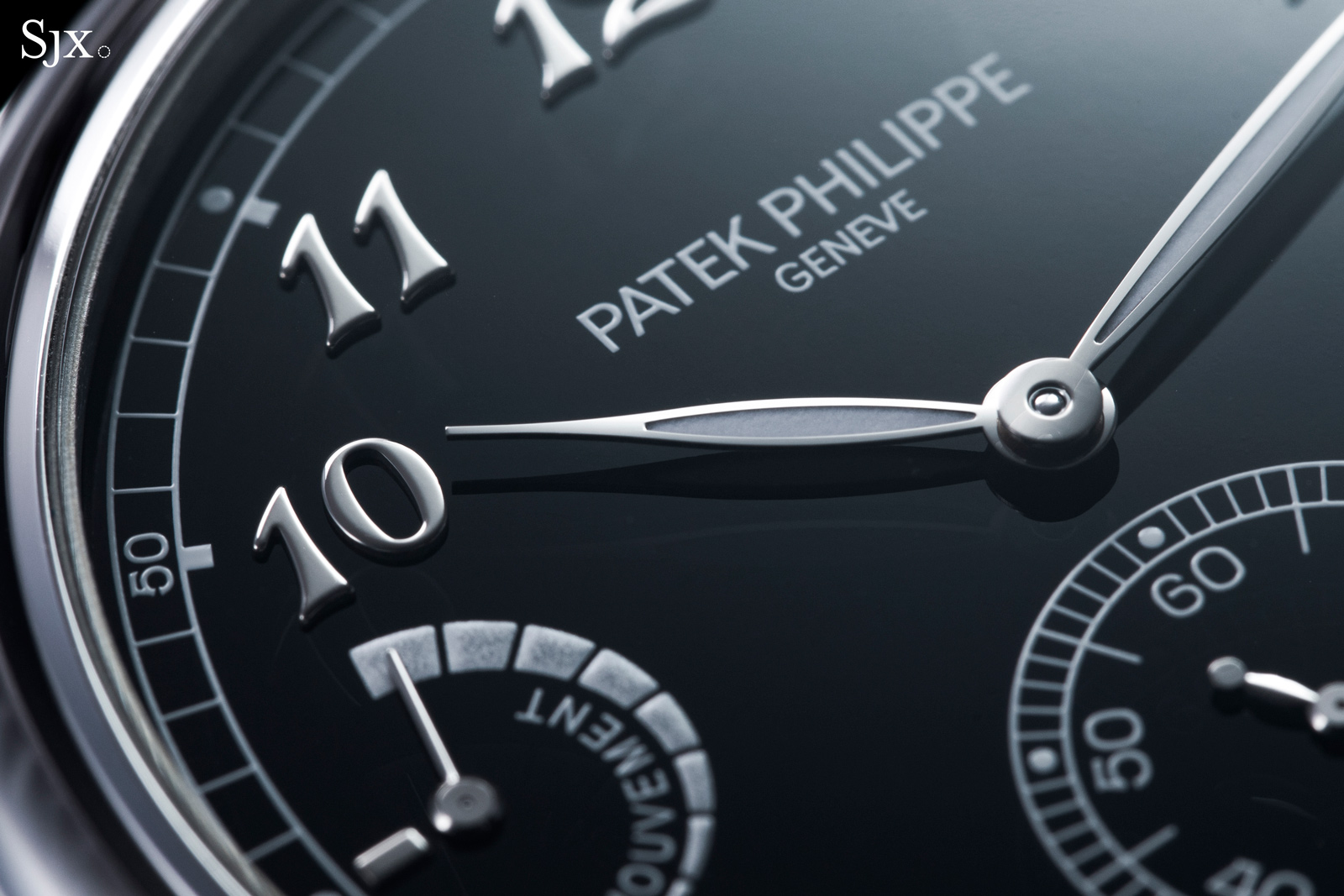
The fact that the watch is contemporary is evident in the movement, which looks and functions like a modern calibre, reflecting Patek Philippe’s measured, but consistent push forward in movement technology. Derived from the calibre in the Grandmaster Chime, the GS 36-750 PS IRM within the ref. 6301P is a nod to the brand’s pocket watches of the early 20th century, but also incorporates technology – both the hairspring and jumping-seconds mechanism are silicon.
Contrast it to the the Code 11.59 Grand Sonnerie Carillon launched by Audemars Piguet a month before. Although the Code 11.59 Grande Sonnerie is tremendously complicated, extremely well finished – and equipped with a paillonné dial made by the famed Anita Porchet – it is powered by a movement that is, at heart, almost 30 years old.
At the same time, the ref. 6301P’s movement is finished extremely well, revealing details that put it in a class above most other Patek Philippe complicated watches. Though the bridges are mostly large and lack of the slender, graceful lines of vintage movements, it is still an attractive looking calibre, especially when admiring the finishing.
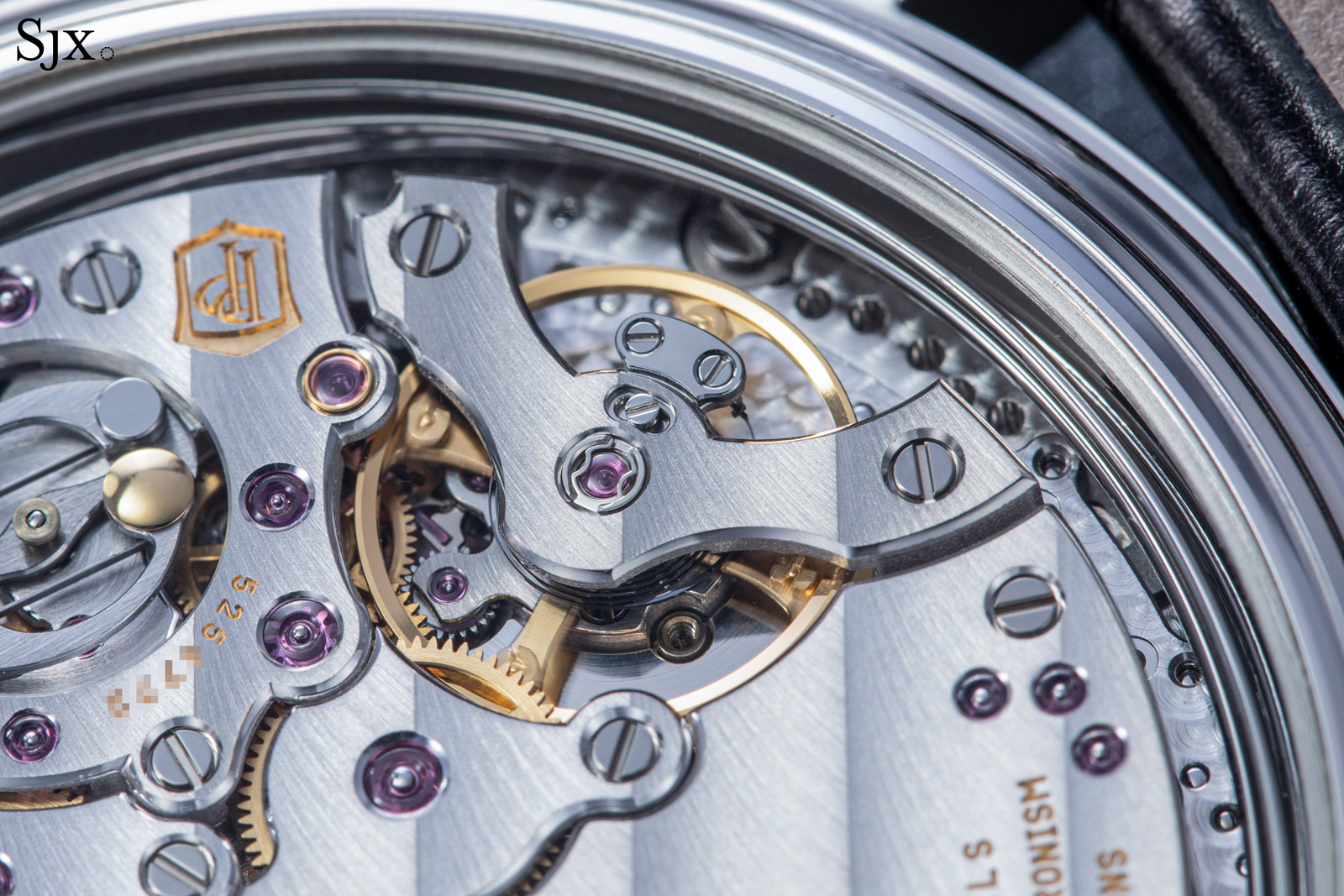
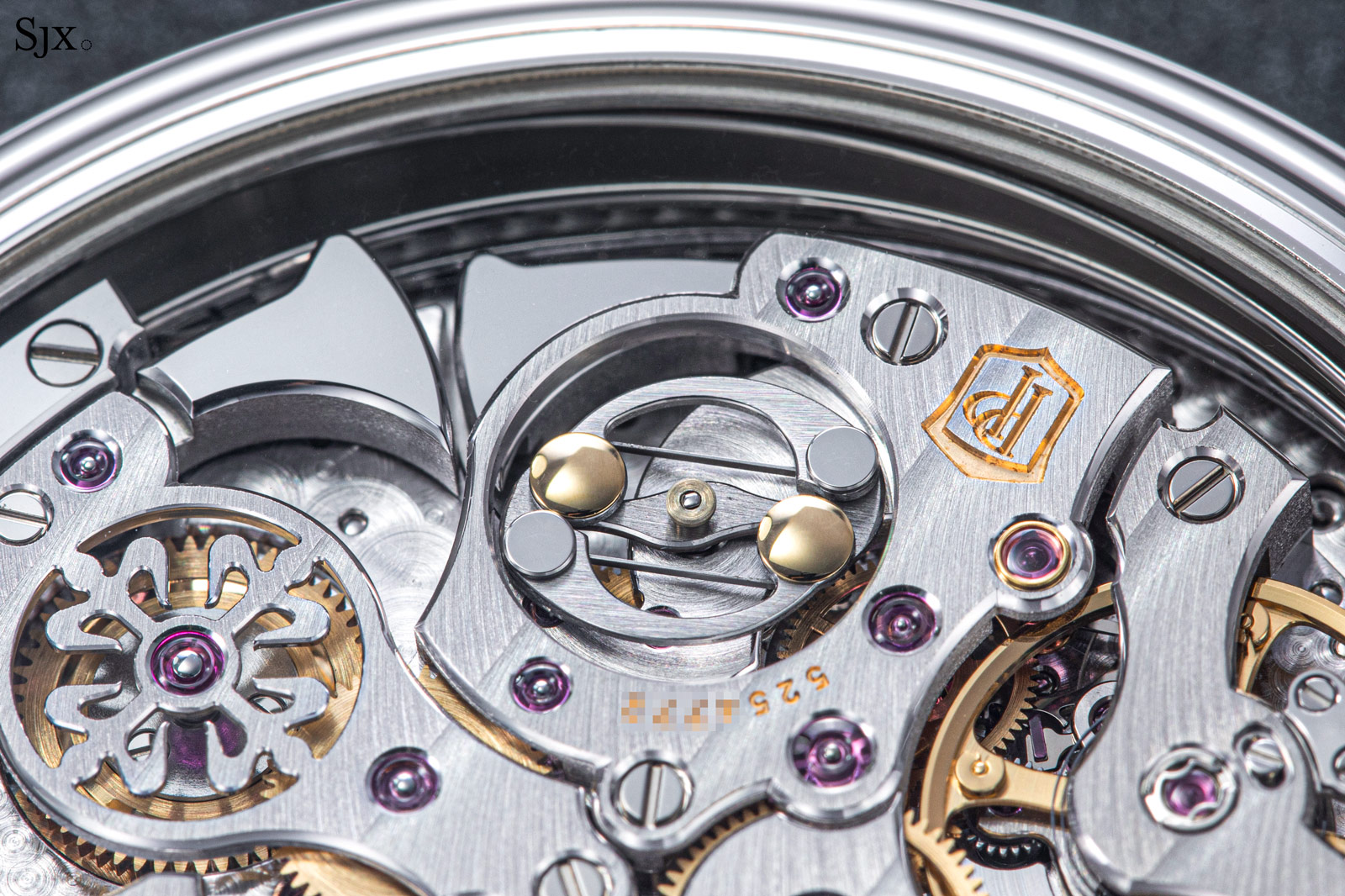
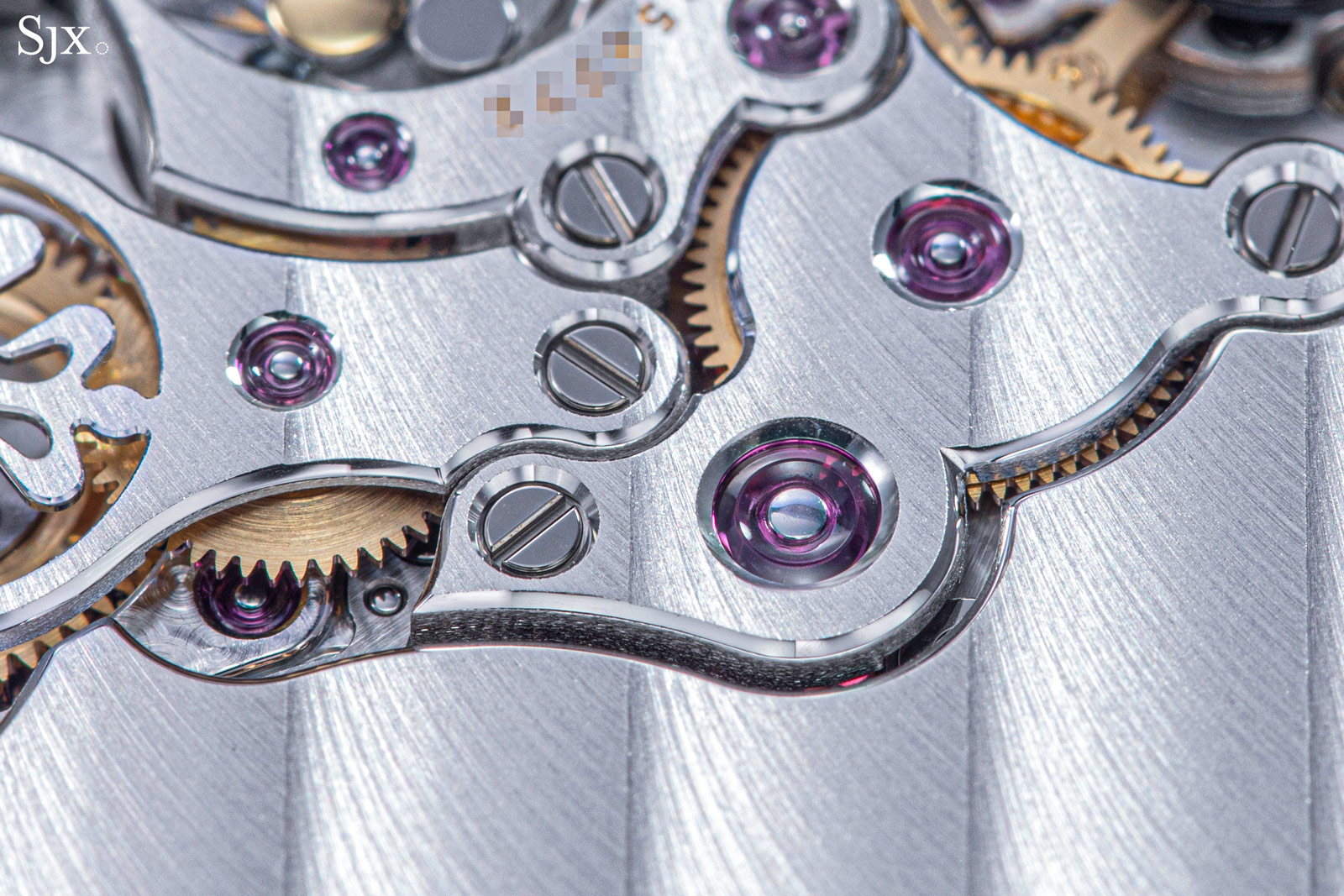
The carefully shaped bridges allow for more elaborate finishing
And most crucially, the ref. 6301P fulfils its purpose well – the grande sonnerie chimes loudly and clearly in pleasing tones. In fact, it is surprising audibly, despite the mass of the platinum case – proving Patek Philippe does produce consistently excellent striking watches of all types.
Costing about US$1.2 million, the ref. 6301P is well beyond affordability for me, but I can grasp the appeal. It is a magnificent watch.
The grandest of complications
Widely regarded as the complication in sheer mechanical complexity, the grande sonnerie has long regarded as the ultimate achievement for a watchmaker.
A grande sonnerie is essentially a miniature longcase clock that strikes the time as it passes. It is able to sound out the hours and quarters as they pass – which means 35,040 times a year – while also being a minute repeater, able to sound the hours, quarters, and minutes on demand.
To do that, a grande sonnerie movement is made up of two segments, each with its own mainspring. One is the gear train that keeps the time, while the other drives the striking mechanism. The result is a truly complex movement. While an high-end, time-only movement might be made up of 120 or so components, the tally for grande sonnerie movement is usually in the range of 600 to 700.
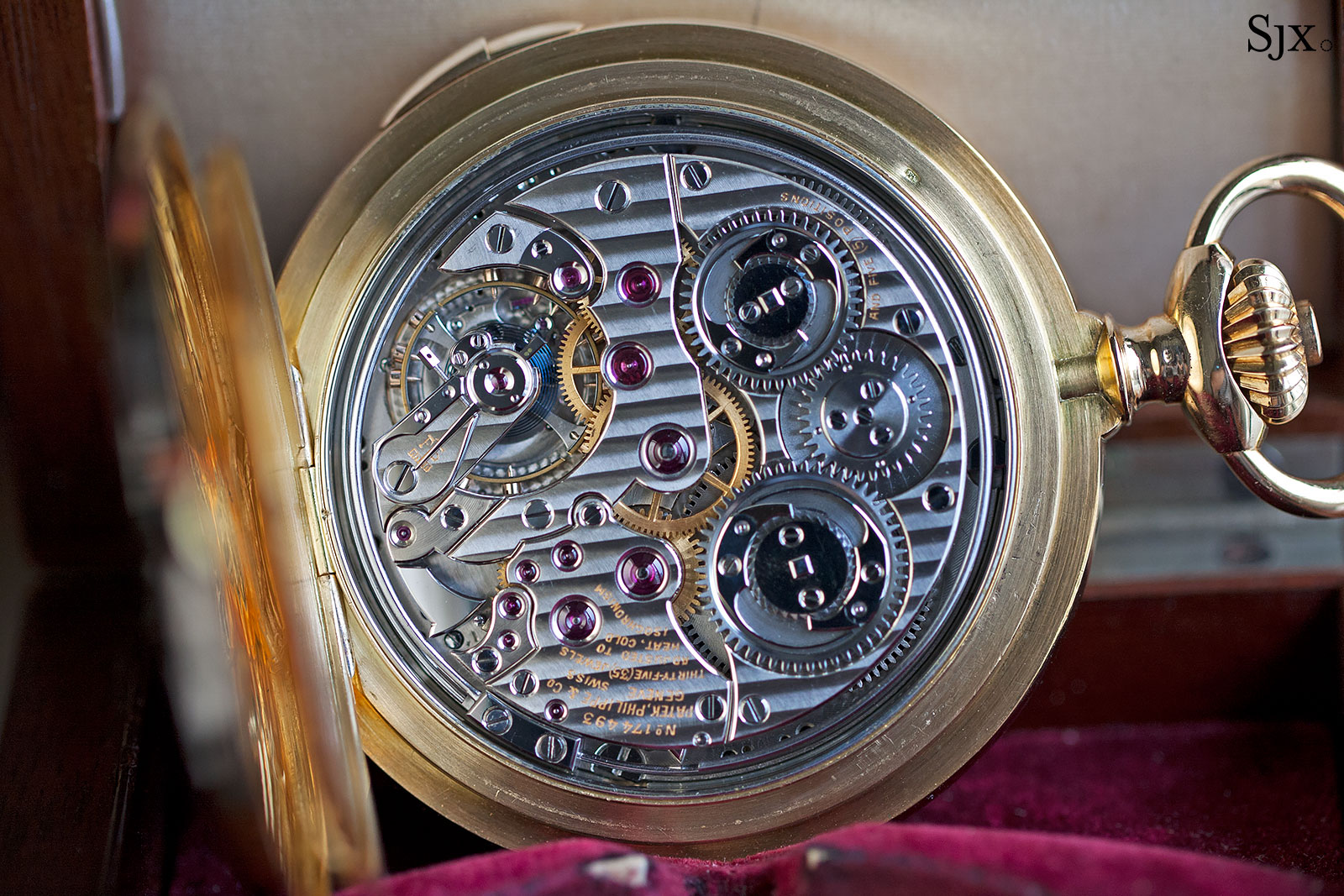
The movement in a Patek Philippe grande sonnerie pocket watch that was made in 1915, but only sold in 1964
Only a handful of watch brands or independent watchmakers have come up with their own grande sonnerie wristwatch – perhaps a dozen at most – and amongst them are names like Audemars Piguet, Philippe Dufour, F.P. Journe, Greubel Forsey, and Vacheron Constantin.
Patek Philippe is a historical maker of grande sonnerie pocket watches, with most having been produced in the early 20th century – though some took decades to sell. It continued the tradition into the modern day, with both the landmark Calibre 89 and Star Calibre 2000 incorporating the complication along with a host of other functions.
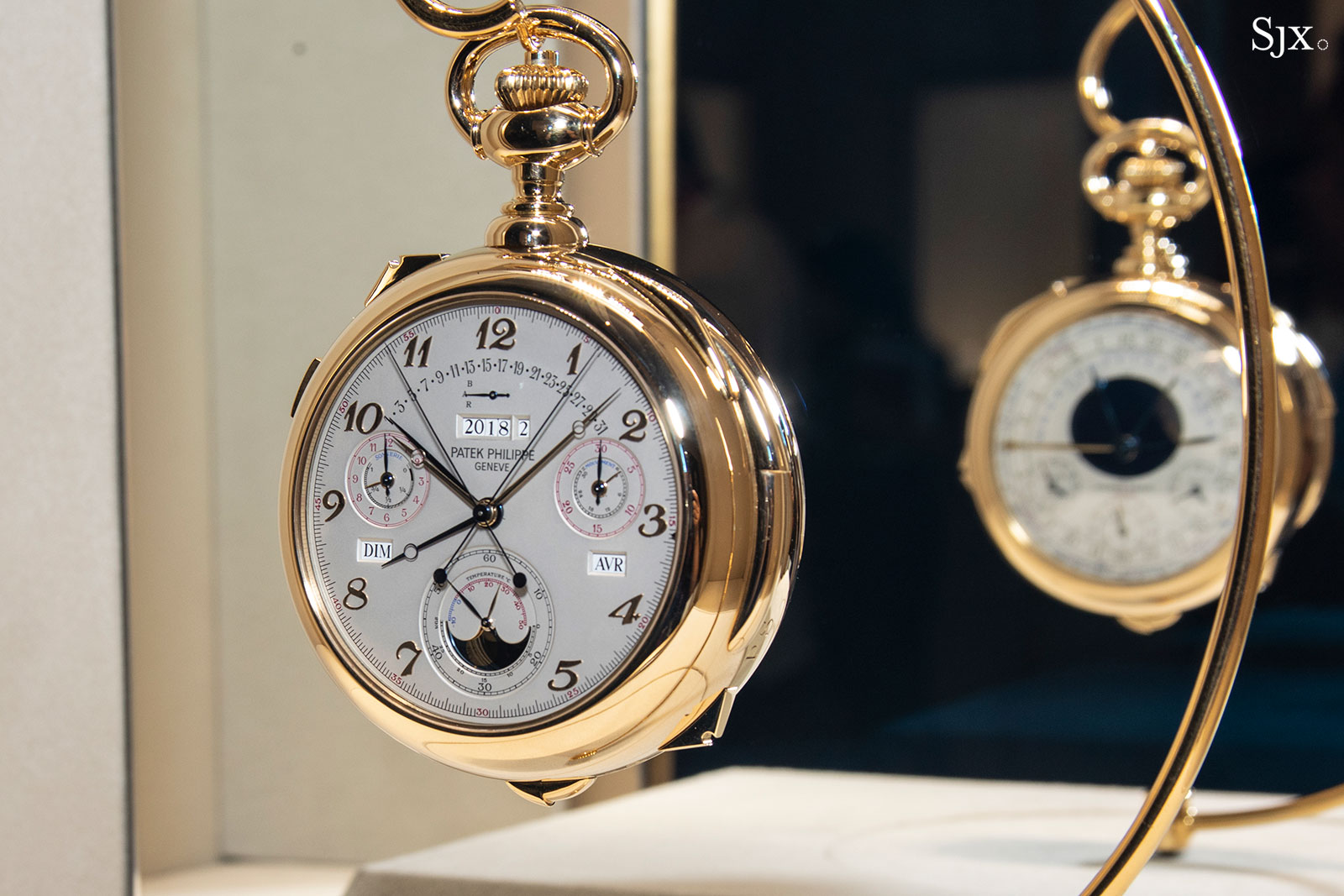
The Calibre 89
The ref. 6301P is the first Patek Philippe wristwatch to be a grande sonnerie in its distilled form. While the Grandmaster Chime ref. 5175J was the brand’s first grand sonnerie wristwatch, it combined the striking complication with several others on a two-faced, reversible case.
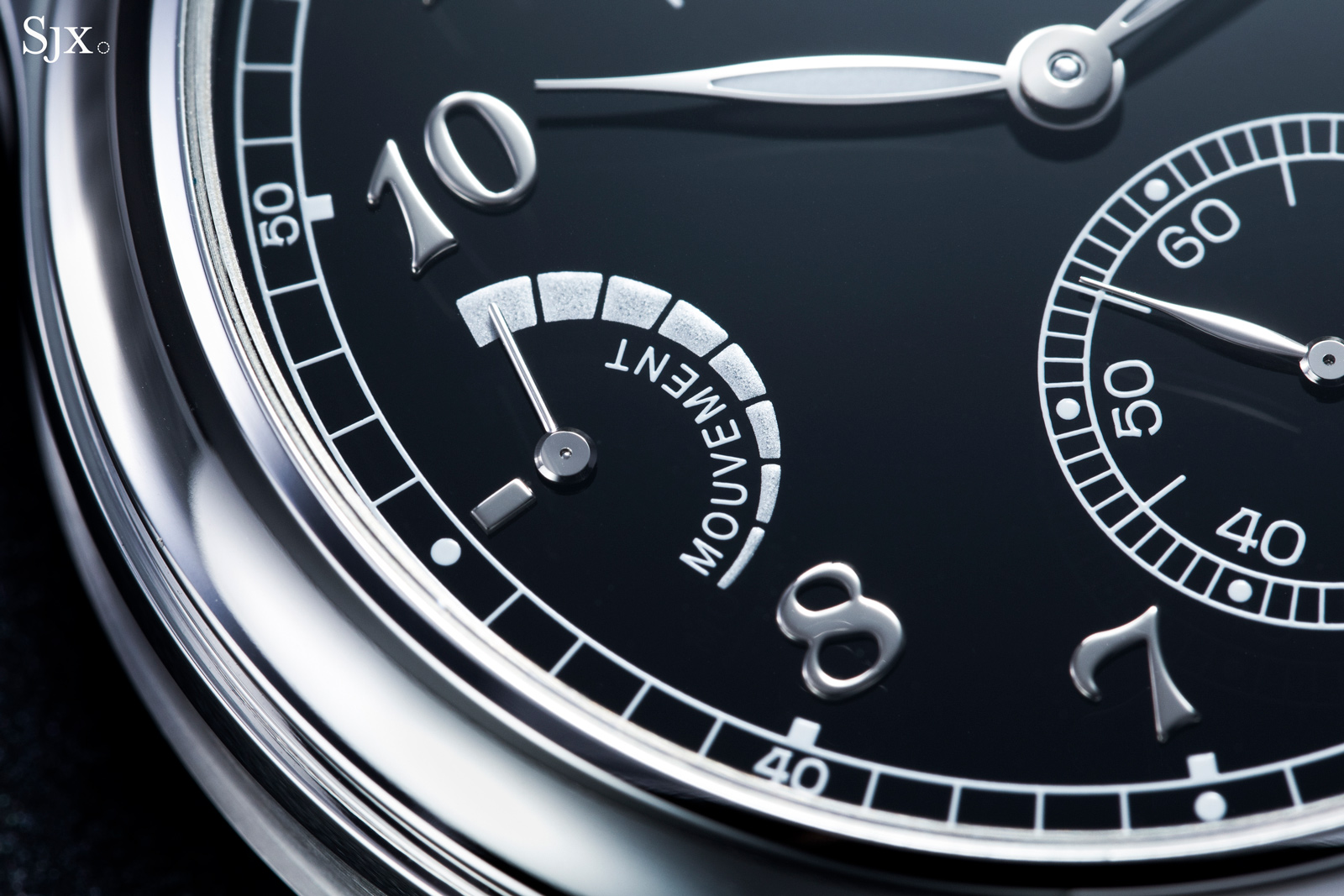
The ref. 6301P has twin power reserve indicators, one for the movement (above), and the other for the strikework
That said, the ref. 6301P is no ordinary grande sonnerie, if there is such a thing. The ref. 6301P is grande et petite sonnerie carillon, which means it chimes the time as it passes in two ways: the hours and quarters as they pass (grande sonnerie), or just the hours (petite sonnerie). And it does so on three pairs of hammers and gongs, rather than the conventional two – hence carillon – so the quarters are sounded with a triple, rather than a double, note.
The ref. 6301P also includes a minor, but interesting complication: an independently-driven deadbeat seconds at six o’clock that relies on silicon components for efficient and lubrication-free function.
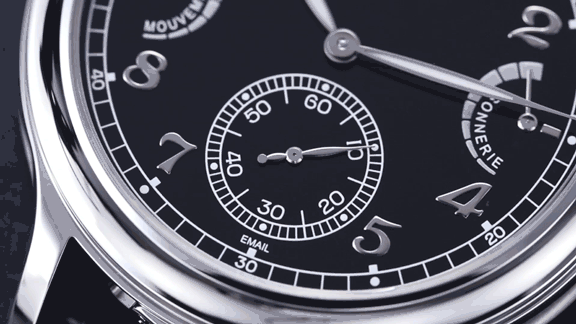
Inspired style
A case style first seen on the split-seconds chronograph ref. 5370P introduced in 2015, the design is one inspired by Patek Philippe chronographs of the 1940s, specifically the split-second ref. 1436. It is characterised by widely-spaced but slender lugs. The ref. 5370P elaborated upon the look by adding detail to the case flanks, something replicated in the ref. 6301P.
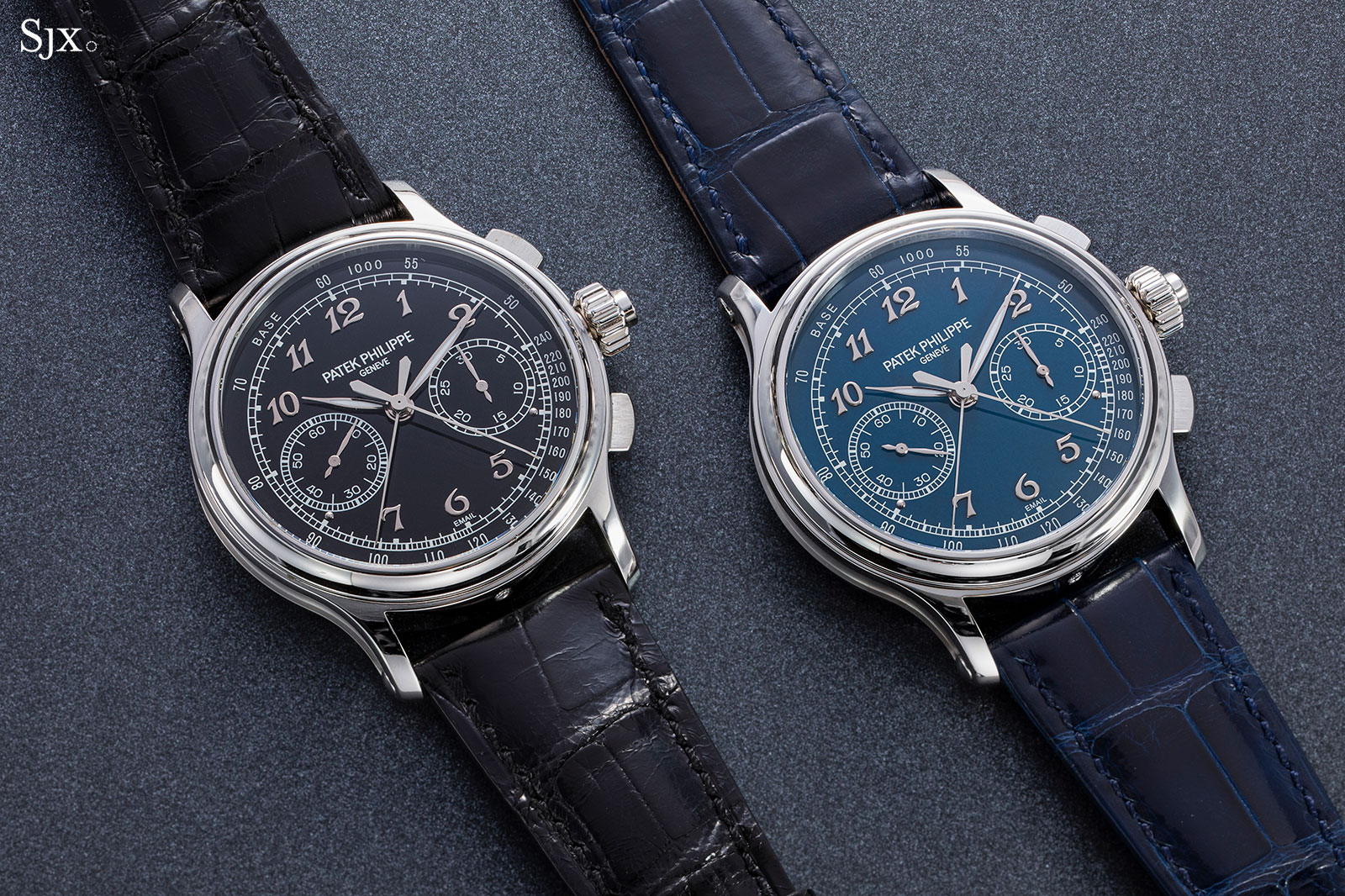
The ref. 5370P split-seconds chronograph in both its guises
The ref. 6301P seems slim, despite its near-45 mm diameter. At 12 mm high, it is actually reasonably thin for a watch of this magnitude, but its perceived height is also helped by the case design.
Seen from the side, the case is made up of a flat back, thin-ish middle, plus a rather high, concave bezel. The tall bezel helps reduce the apparent thickness of the watch, while its concavity leaves it looking less big from the front.
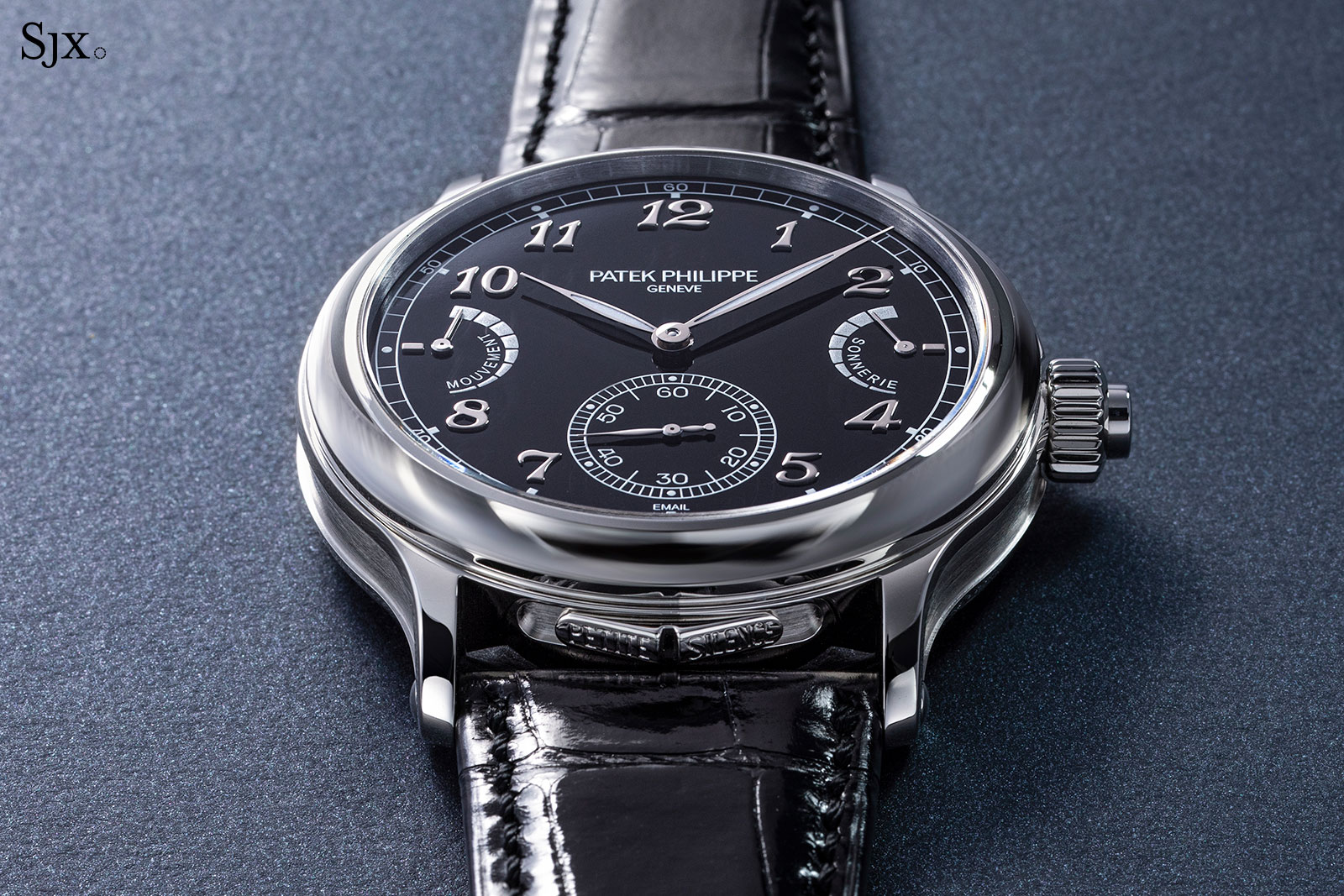
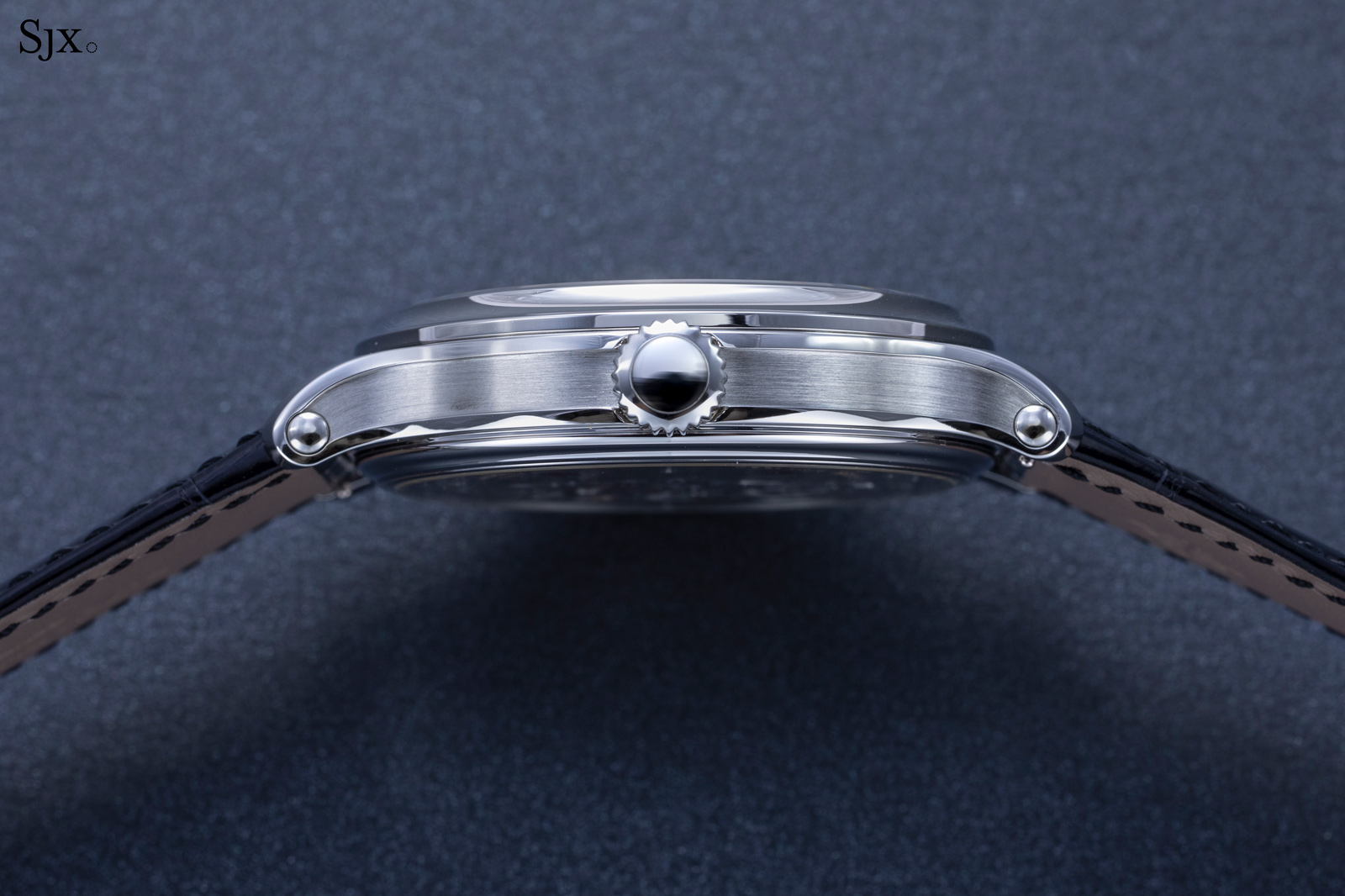
At a distance, the case band appears to be made up of layered parts, but it is actually a single piece. That’s because the flanks have a pronounced recess that’s brushed, while being outlined by a raised, polished border. And the end of each lug is capped by a platinum disc that’s press fitted, fixing it permanently like a rivet.
All this makes for a seemingly ordinary case, but its simple lines belie the challenge in finishing. Being one piece, the case middle first requires several steps to finish. First the recess is filed down to smoothen it, and then a small rotary polisher fitted with a narrow disc is used to apply the brushed finish. That’s followed by the final step of hand finishing with a stick of soft, abrasive wood to refine the brushed surface.
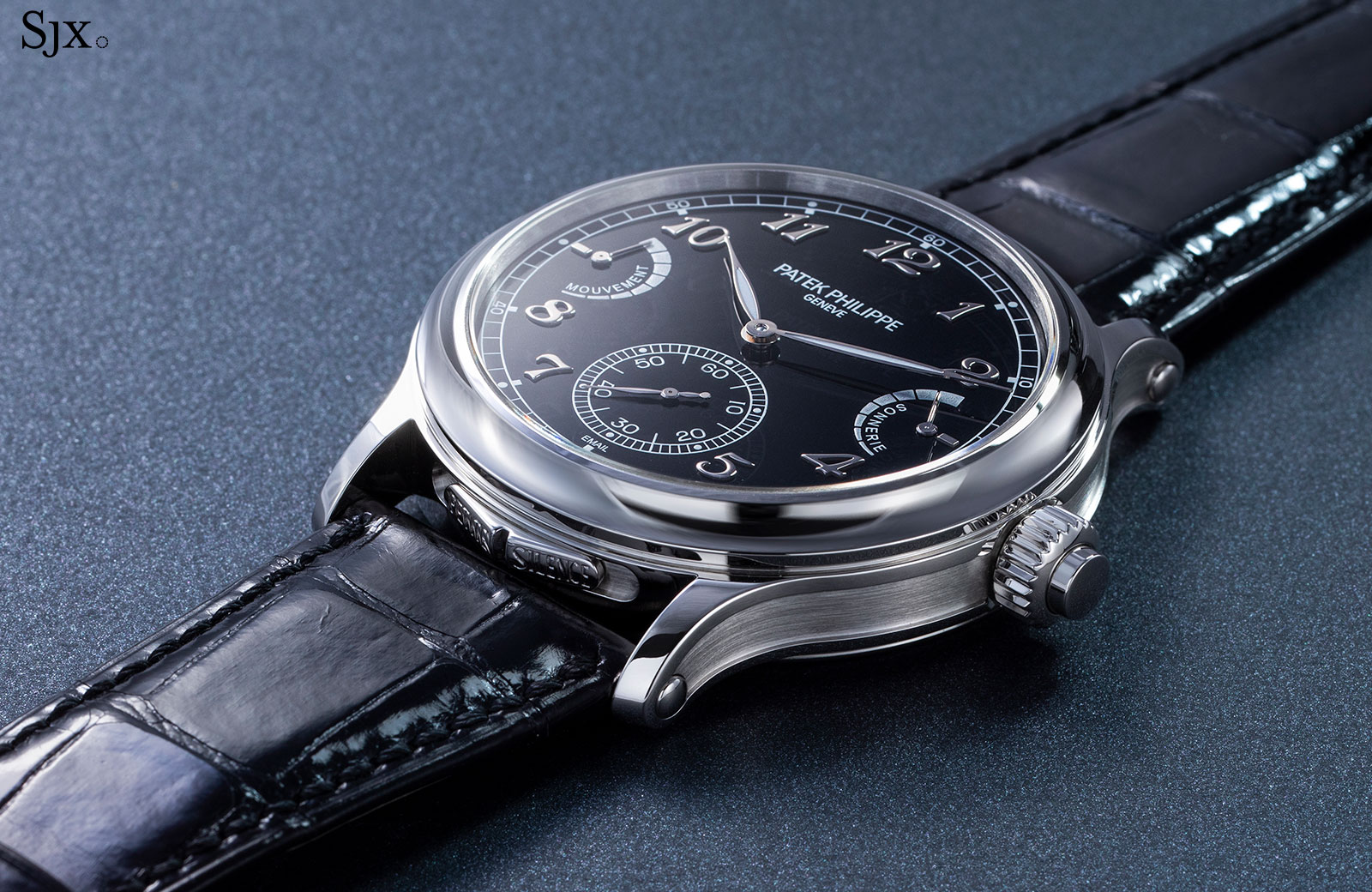
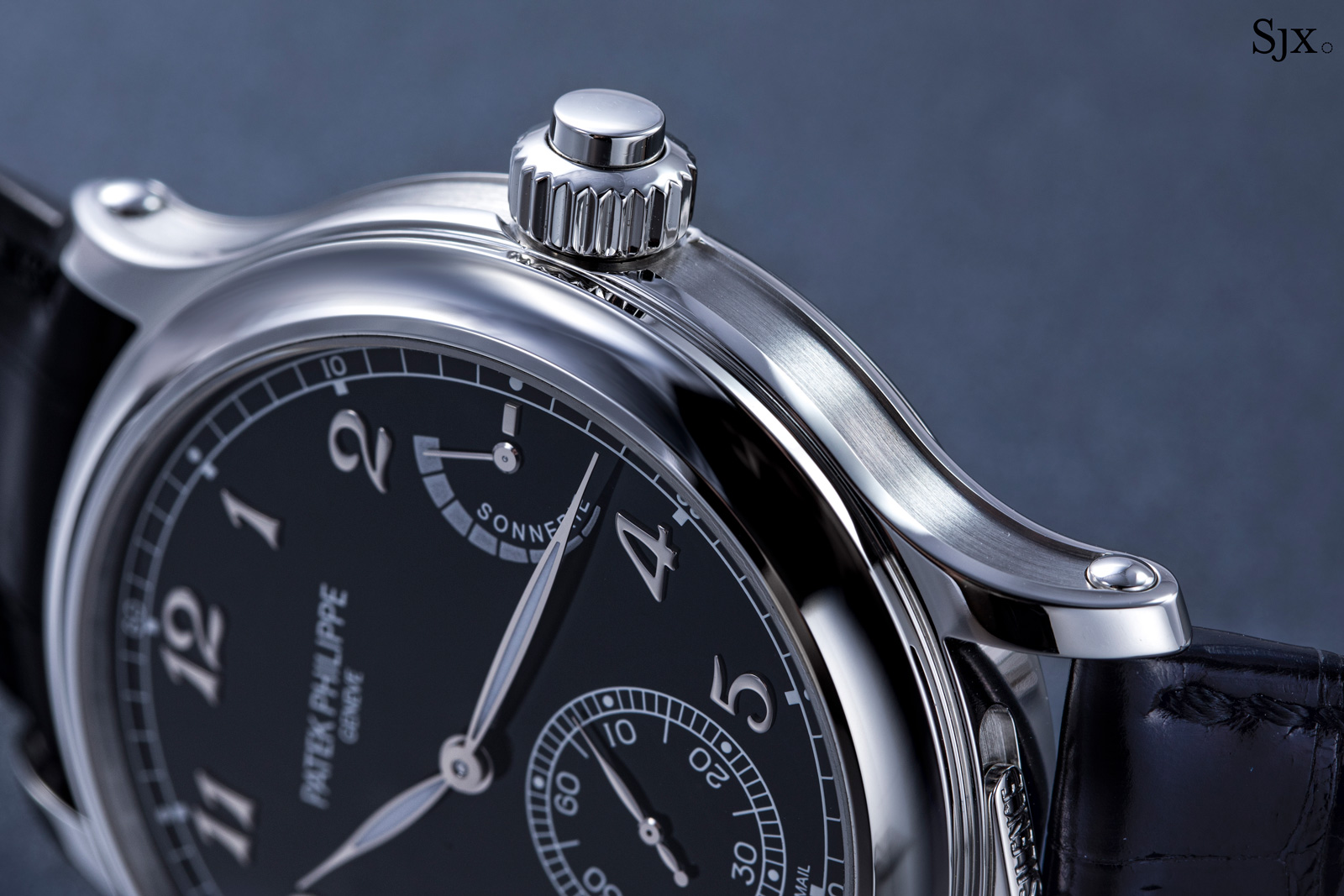
Despite the highly-complicated movement within, the case interface is simple. There’s a button co-axial with the crown to activate the minute repeater, and a function-selector slide tucked in between the lower lugs. In grande sonnerie mode the watch will chime both the hours and quarters as they pass, while in petite sonnerie mode it will only sound the hours. And in silence mode, the watch will only strike if activated via the pusher.
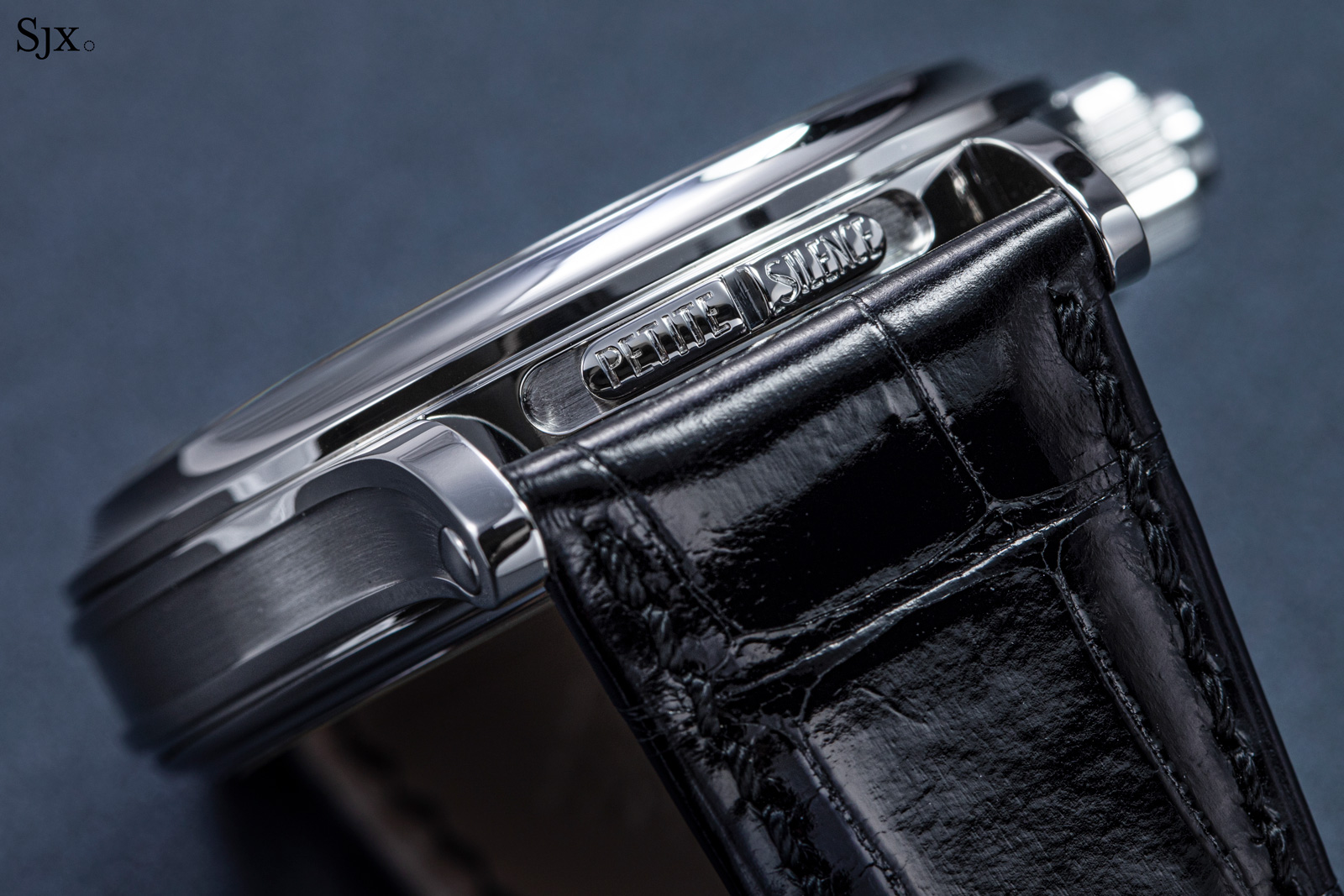
The function-selector slide
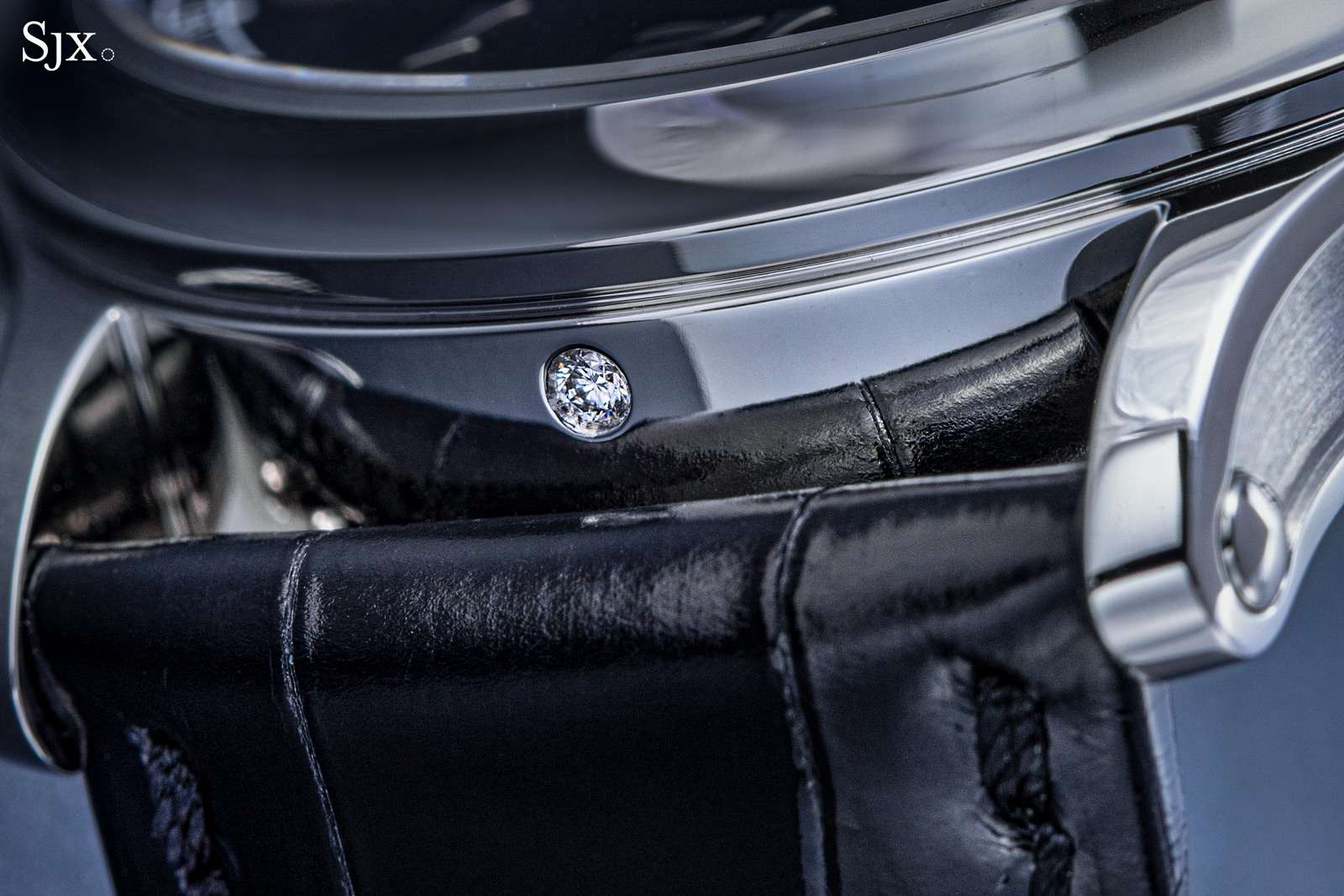
Located in between the lugs at 12 o’clock is a small diamond, a feature found in of Patek Philippe’s platinum cases to distinguish them from their white gold counterparts
Émail
As it is with the case, the ref. 6301P is modelled on that found in the ref. 5370P split-seconds. It features a solidly classical aesthetic that is balanced, sensible, and expensively executed.
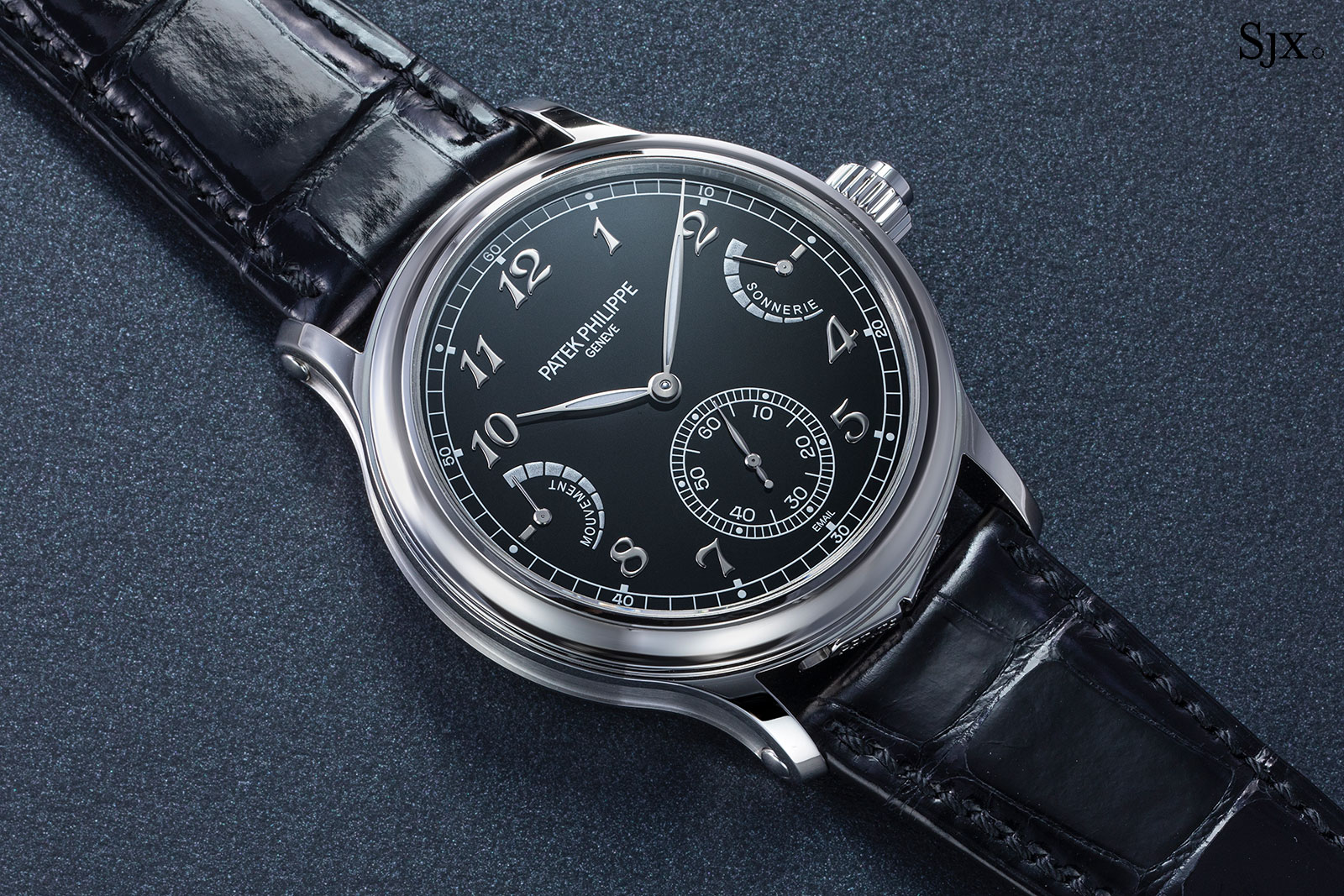
The dial is vitreous enamel, which is essentially glass powder mixed with pigment that is fire in an oven, melting the powder and fusing it to the dial. This dial is almost certainly lapped after it is fired, resulting an a smooth and glossy surface that is almost glasslike.
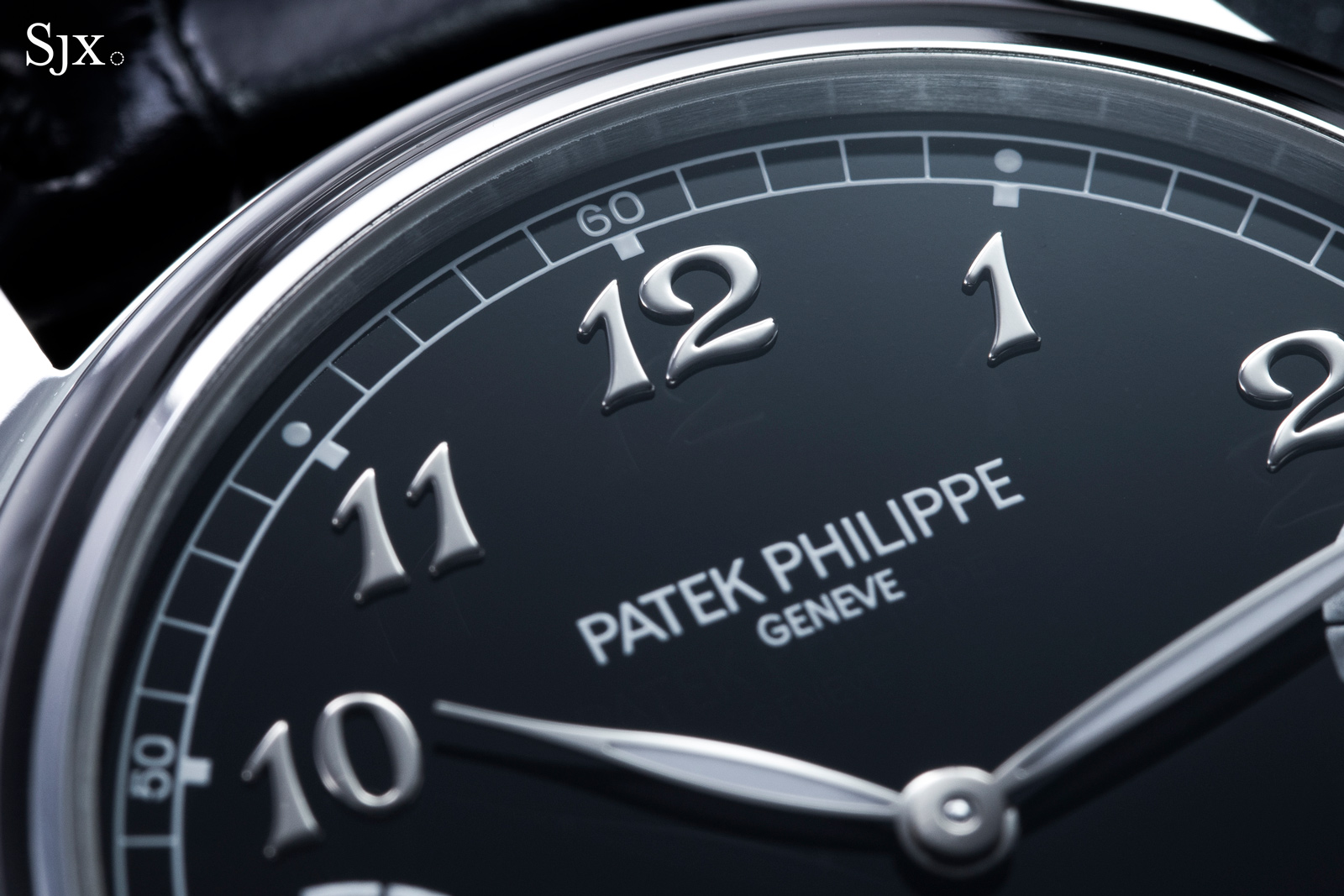
The dial is glossy enough that it reflects the applied numerals…
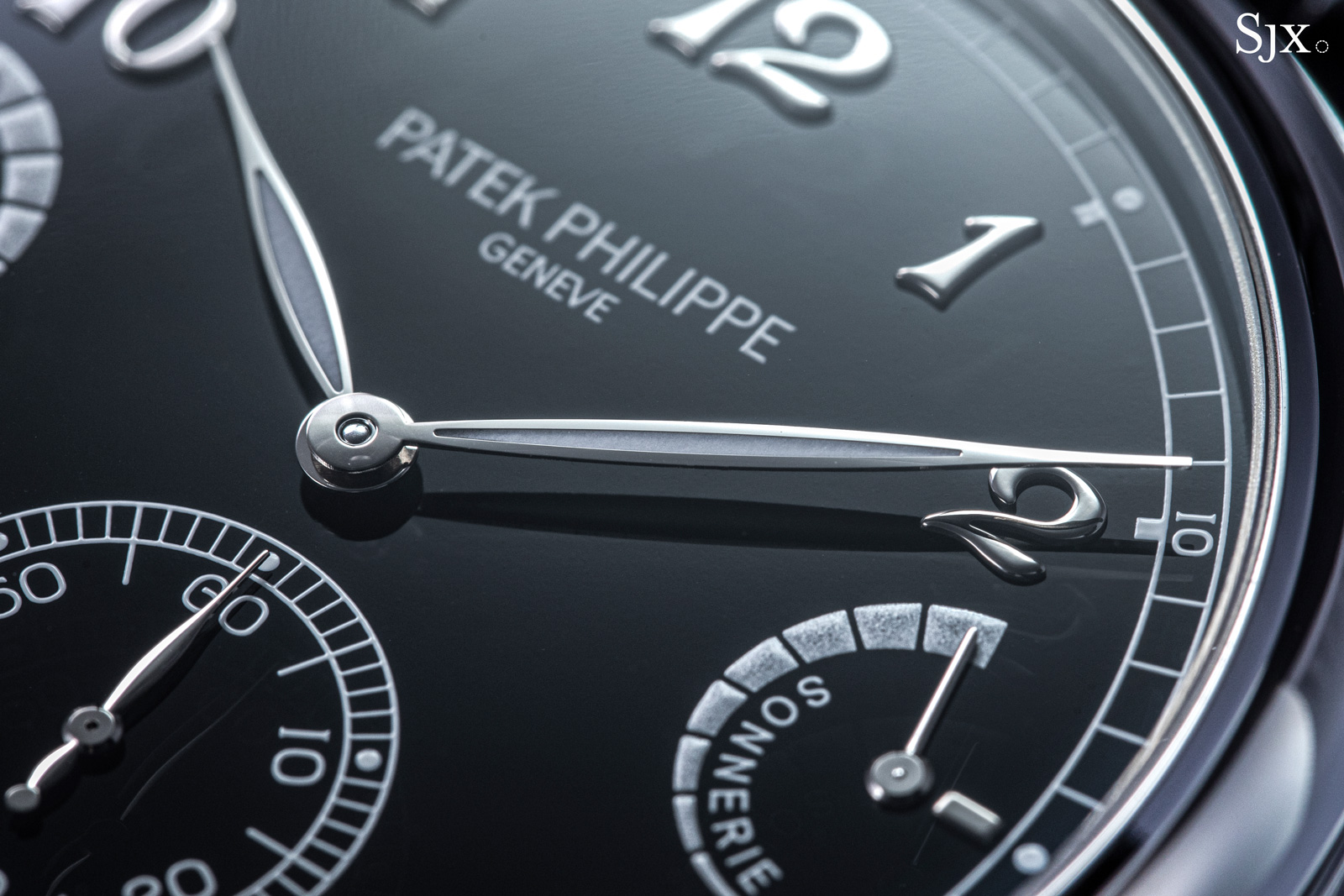
And of course the hands
That’s followed by the markings on the dial, which are done in white enamel for tracks, numerals and logo. The power reserve indicators, on the other hand, are printed in silver poudre, or powdered, lacquer, explaining the metallic granularity of the fan-shaped scales.
And as is typical for Patek Philippe, the applied numerals are solid gold, as are the hands. The Breguet-style numerals are finely shaped, with slightly rounded faces, and especially beautiful.
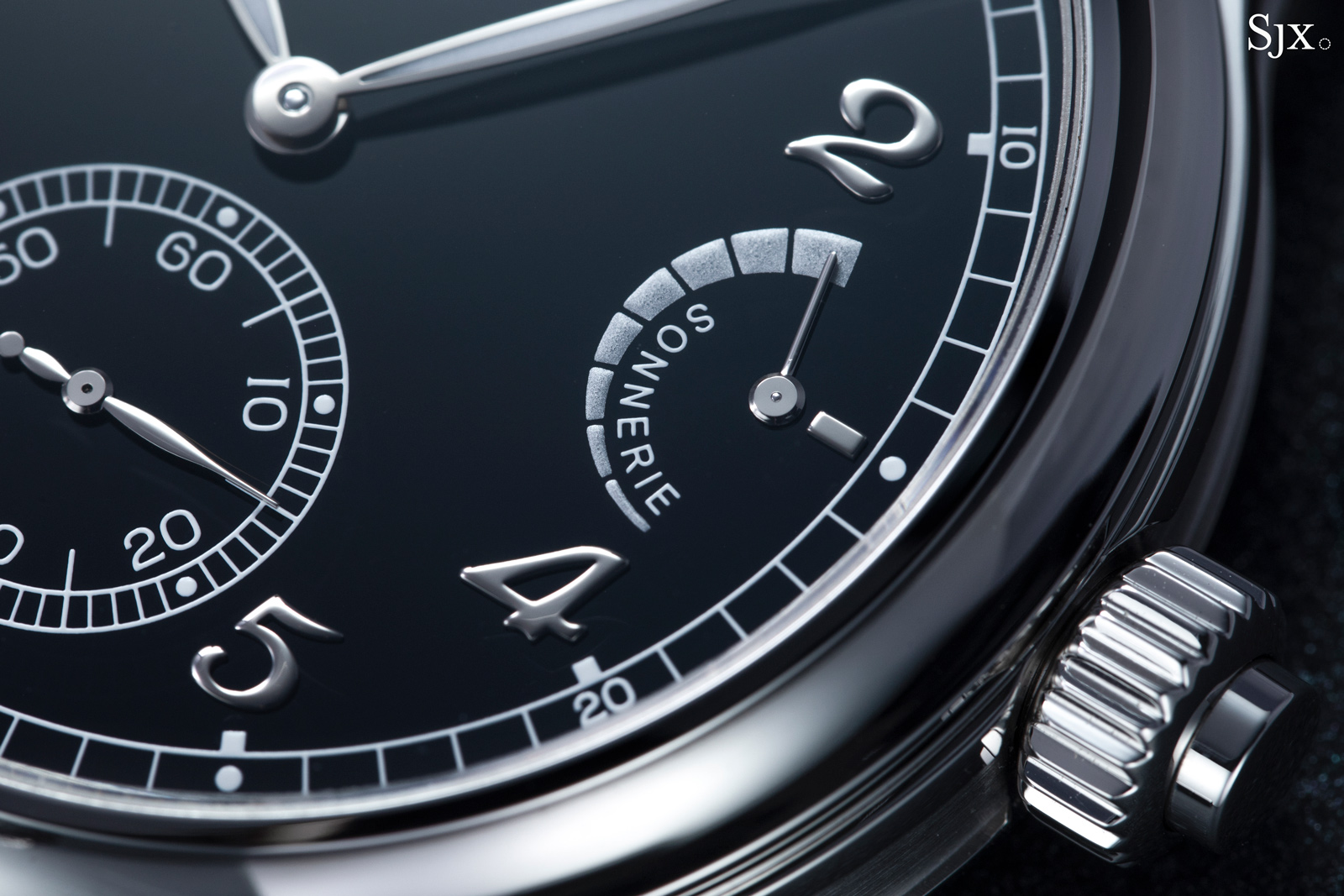
The scales for the power reserve are done in powdered-silver print
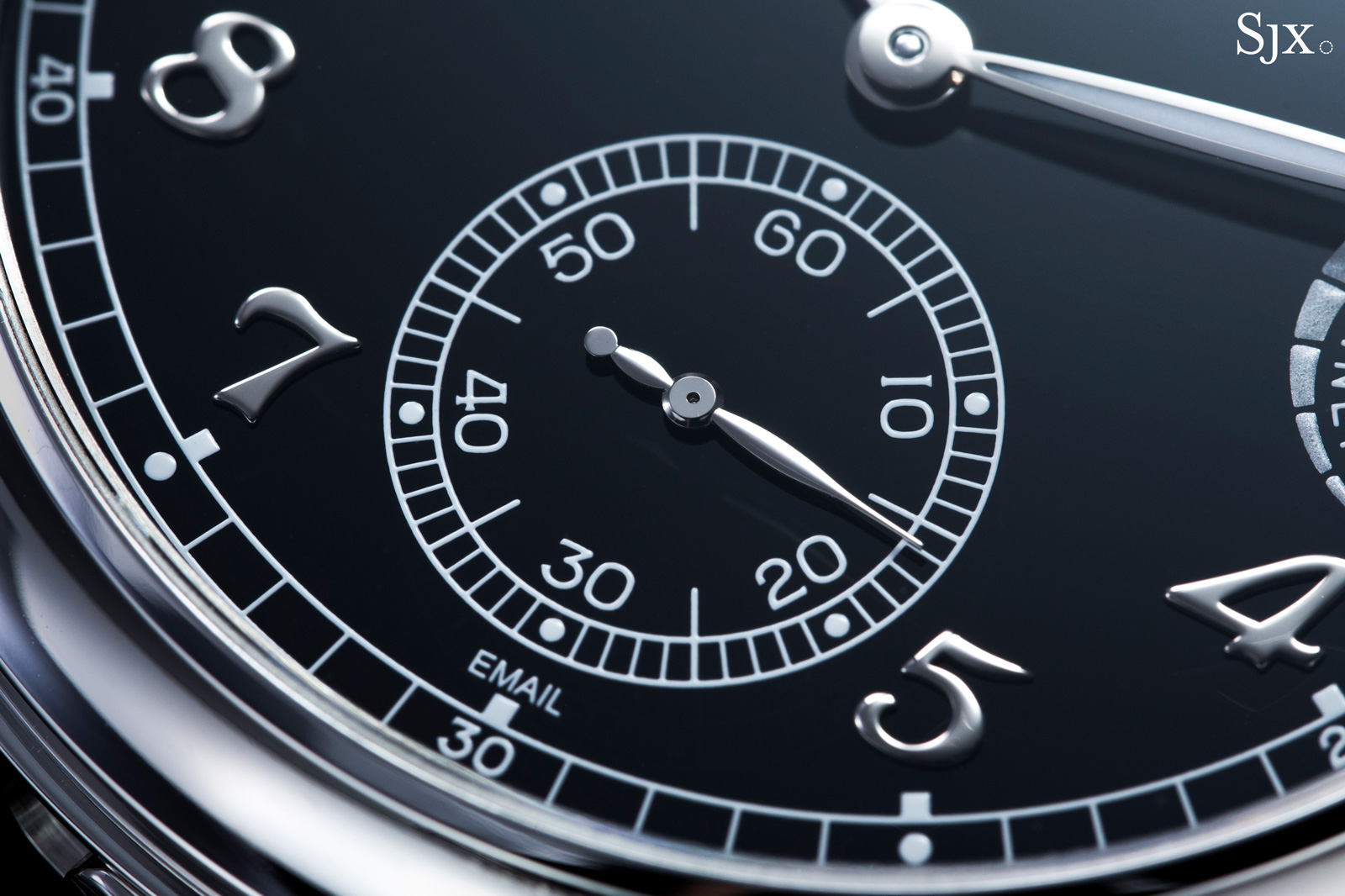
The dial’s quality goes beyond the material. Even up close, flaws aren’t to be found, demonstrating how Patek Philippe’s vertical integration has allowed it to achieve quality across all components.
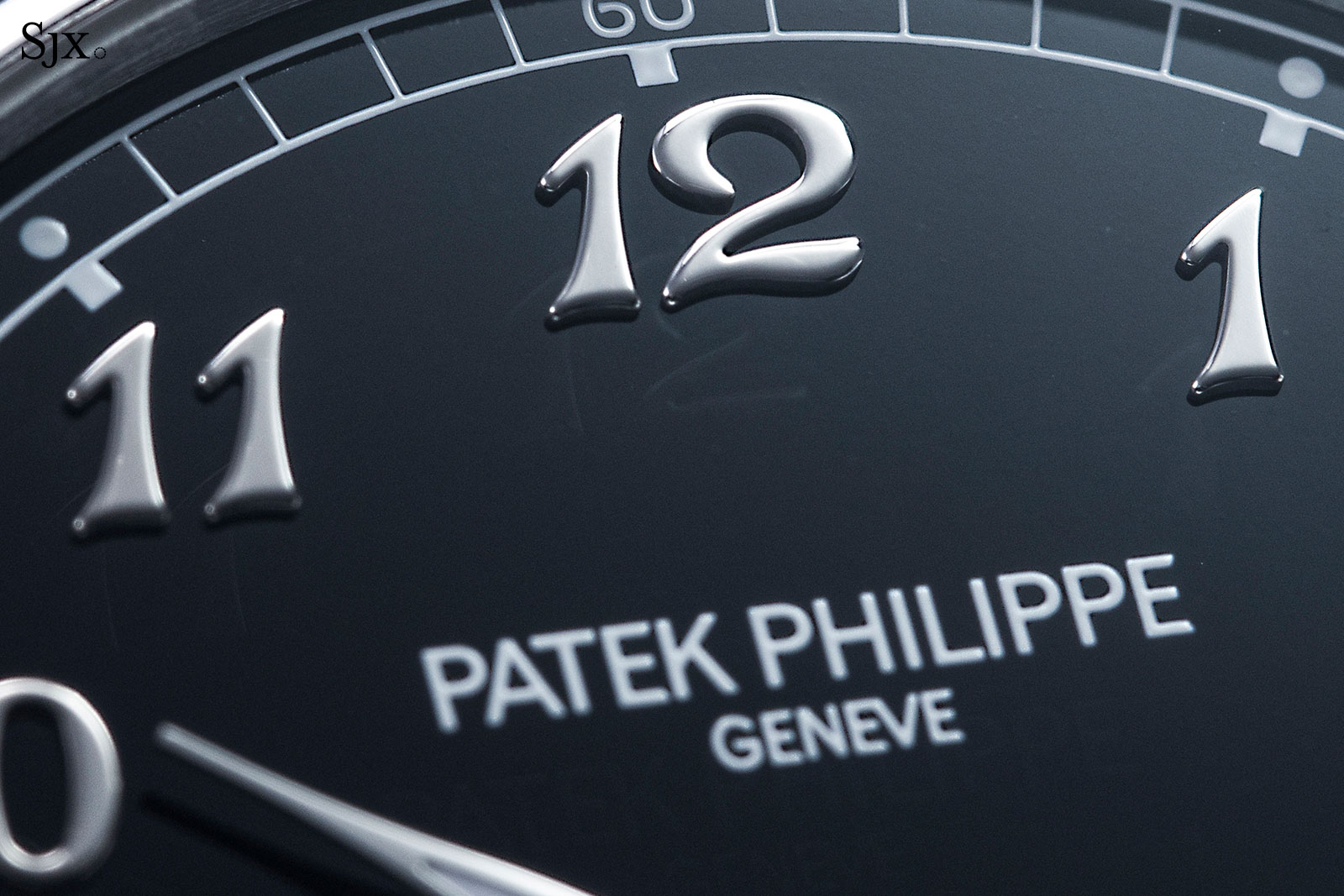
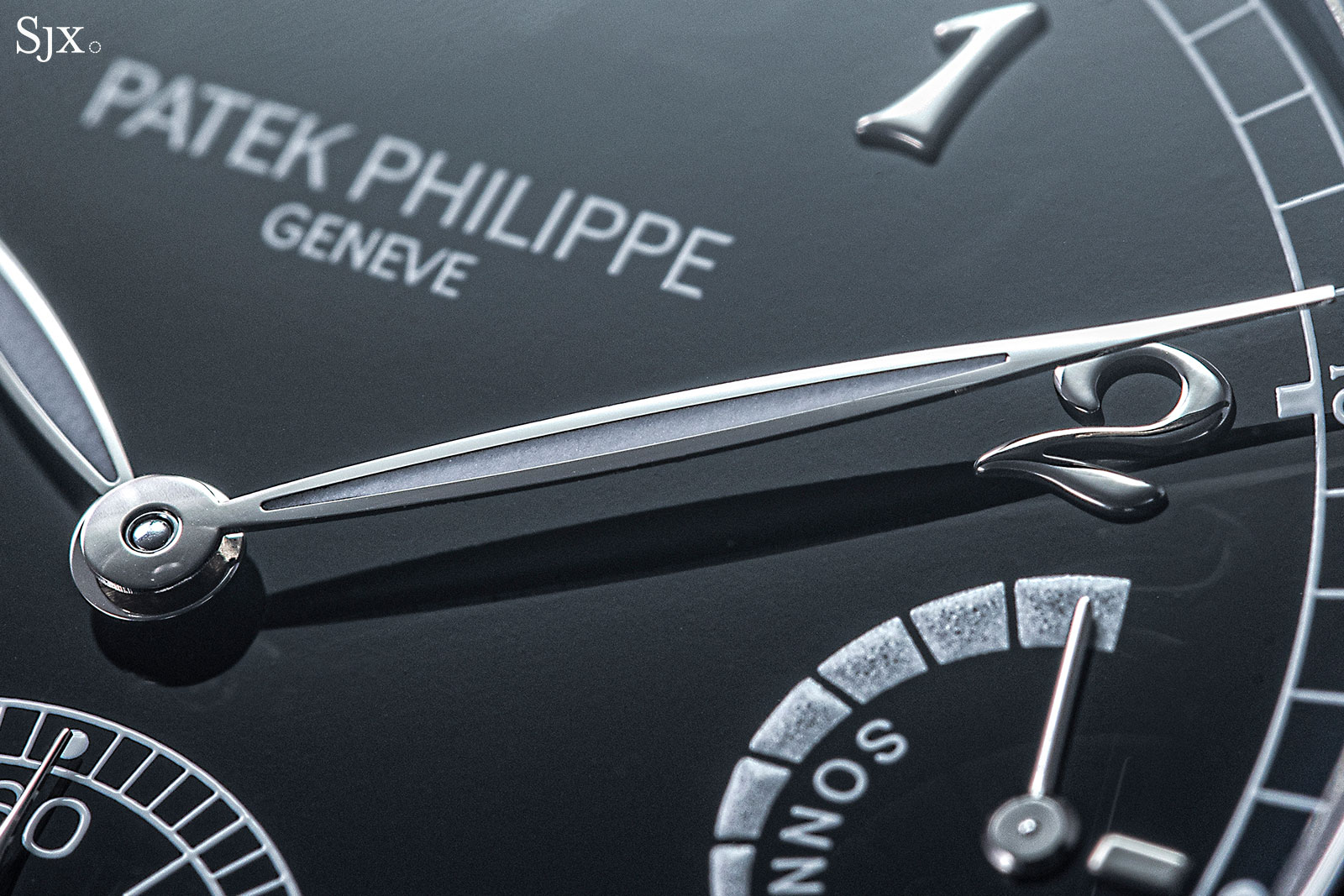
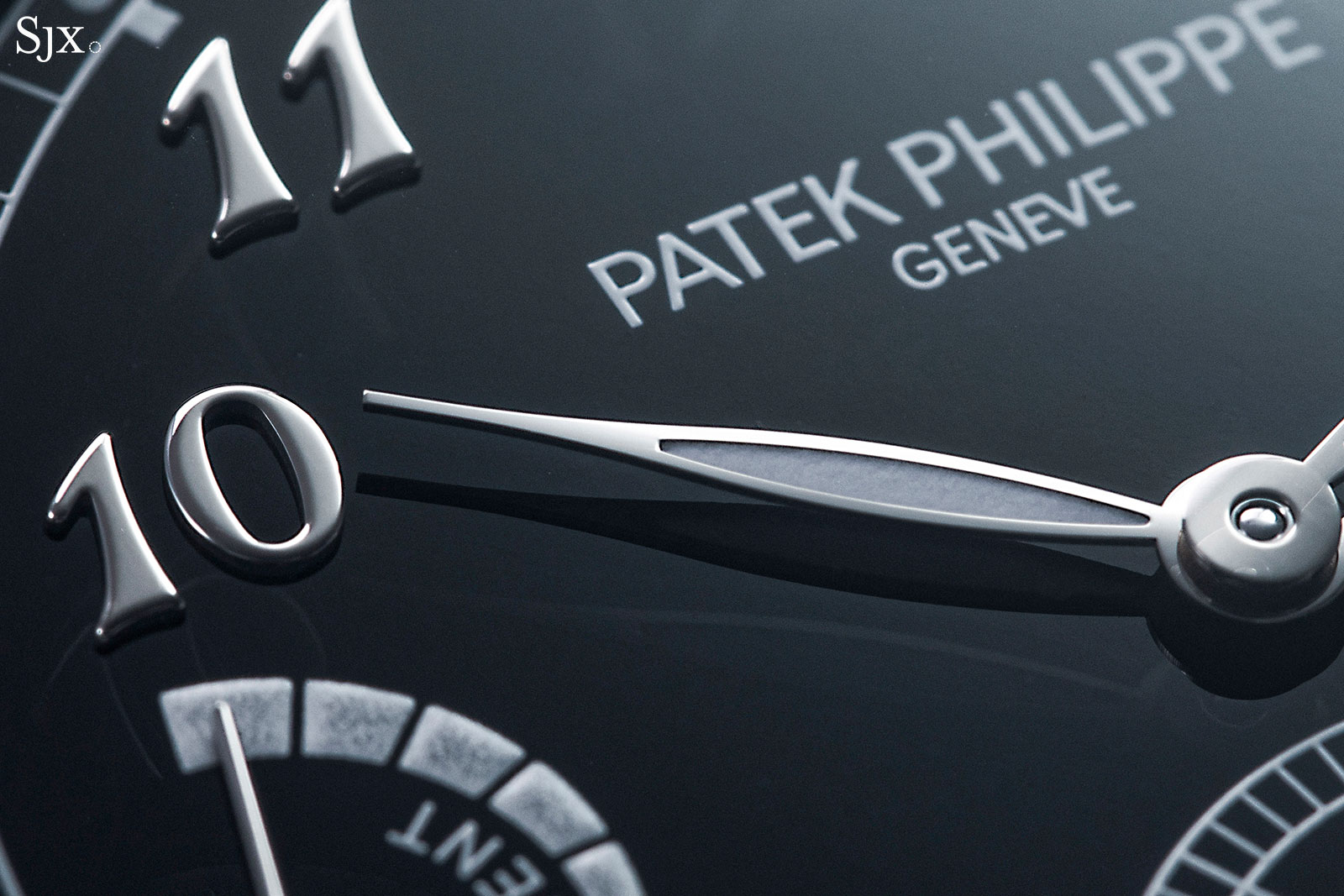
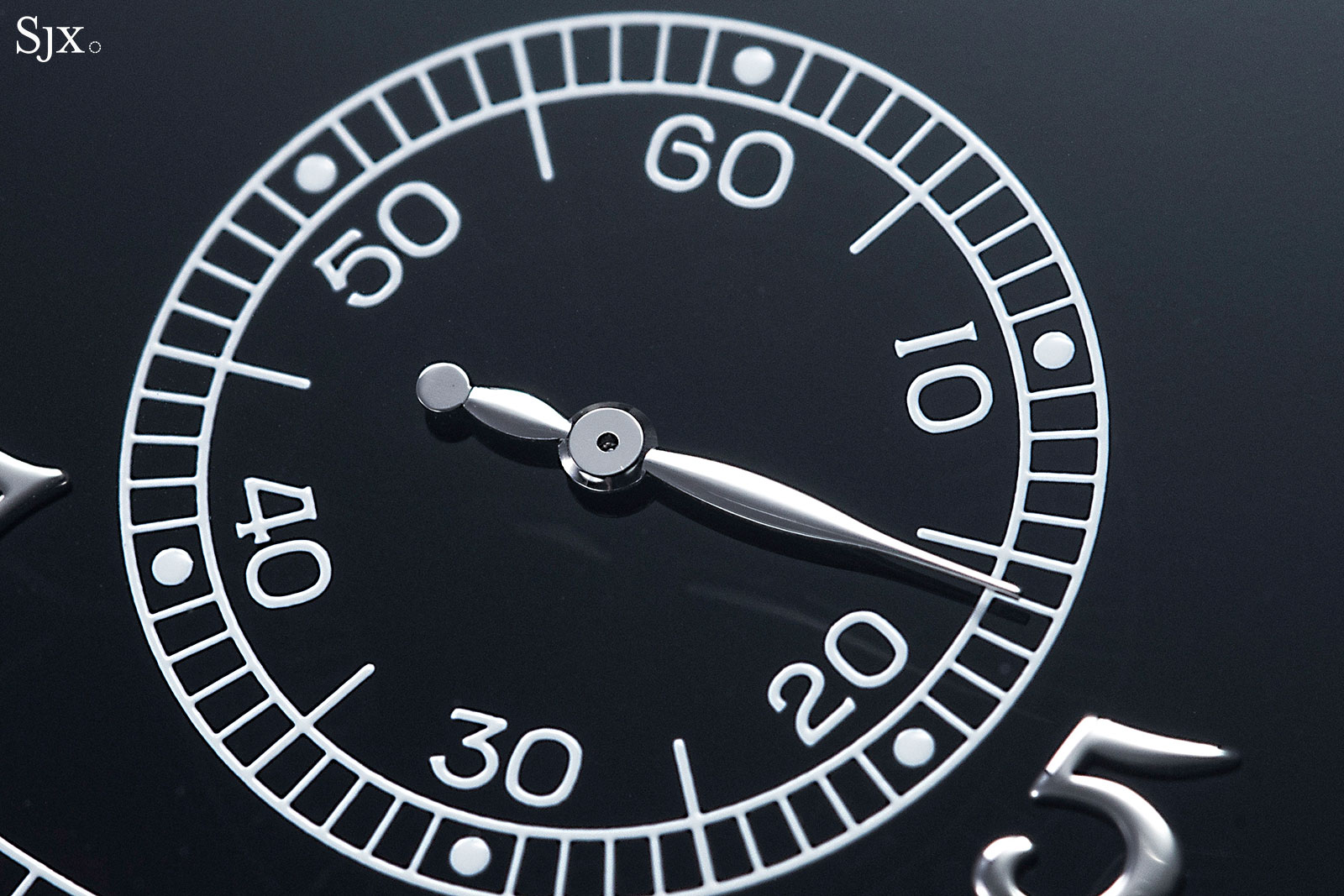
The seconds hand, with its slightly domed profile, is especially well done given its size
If anything, the only criticism that can be made of the dial is aesthetic. The luminous hands feel out of place because the dial itself has no luminous paint. At the same time, they aren’t essential for a minute repeater can be activated for the time in the dark.
And a nitpick lies in the railroad minute track. It is identical to that on the ref. 5370P split-seconds, and features a tiny square marker for each five-minute segment that sits just adjacent to the hour numerals. Unlike on a chronograph where the scale is of paramount important in measuring elapsed seconds, the additional five-minute squares are unnecessary on a grande sonnerie since they aren’t crucial to the utility of the watch; here they break up the outline of the minute track.
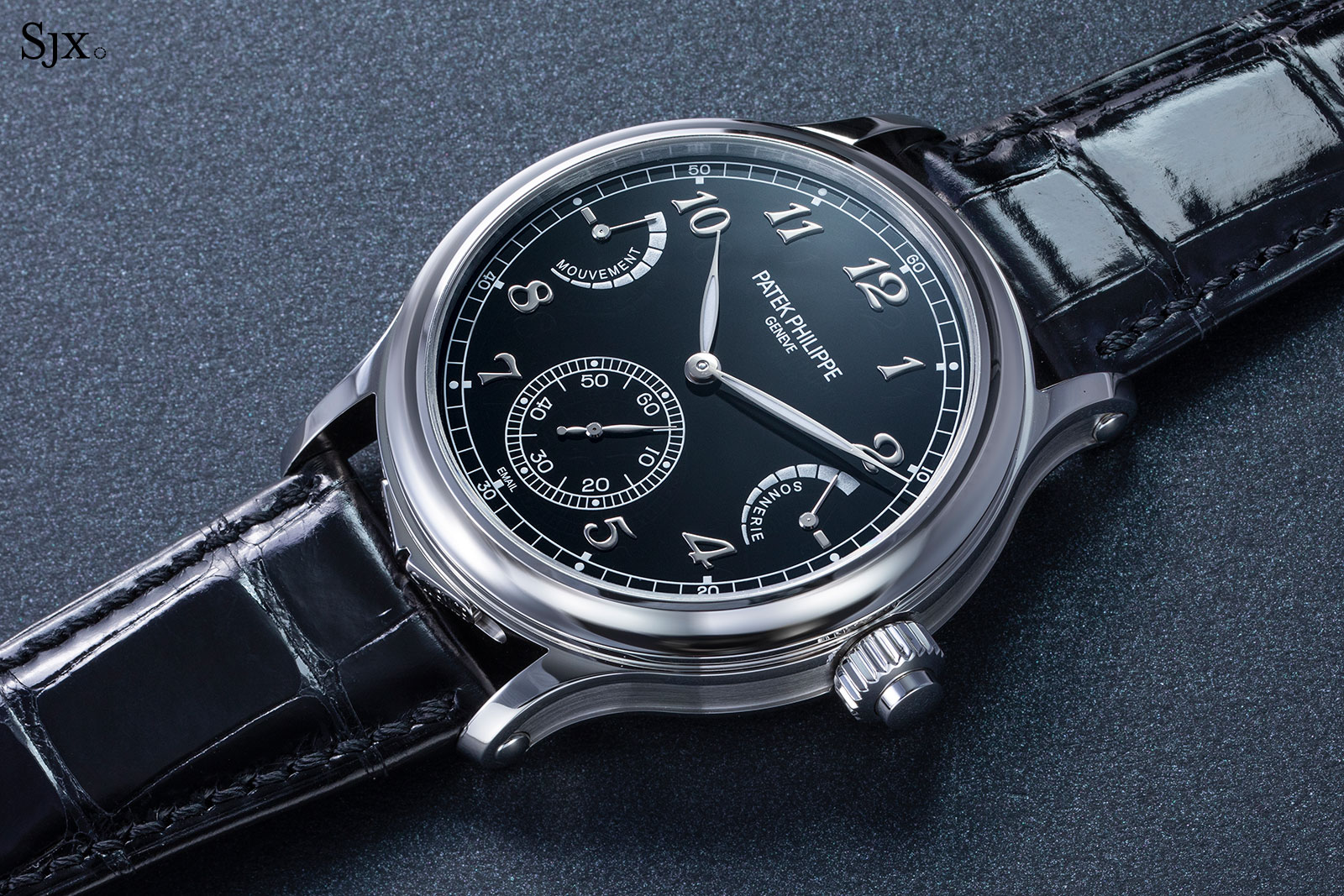
GS 36-750 PS IRM
The movement within the ref. 6301P is derived from the Calibre 300 in the Grandmaster Chime, the mega-complication Patek Philippe debuted for its 175th anniversary in 2014. Essentially the same base calibre, the GS 36-750 PS IRM of the ref. 6301P does away with all of the additional functions that made the Grandmaster Chime the most complicated Patek Philippe wristwatch ever.
Even though it eliminates the perpetual calendar, second time zone, and chiming alarm, the ref. 6301P movement remains remarkably complicated, being made up of 703 parts. In comparison, the R TO 27 PS QI in the ref. 5207 – combining a minute repeater, instantaneous perpetual calendar, and tourbillon – comprises just 557 components.
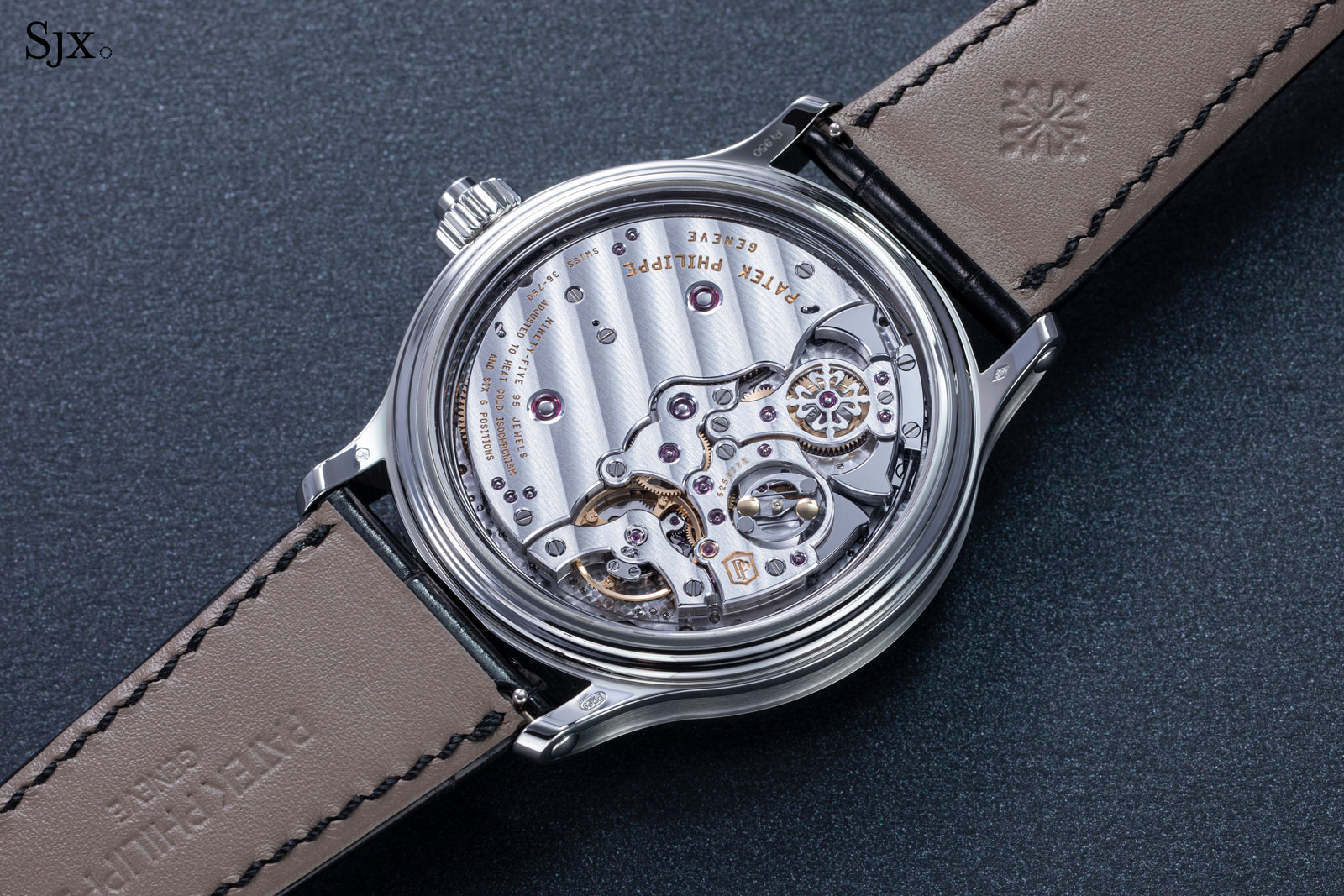
The GS 36-750 PS IRM
A novel feature of the movement that is not apparent through the back is the deadbeat seconds. It modelled on the same complication that was first used in the Chiming Jump Hour “175th Anniversary” ref. 5275P, an intriguing wristwatch that combined jumping hours, minutes, and seconds.
Notably, the seconds is independently driven, which means it is not in sync with the minute hand, although careful setting of the time should be able to accomplish that. And it is also a bit of high tech in a largely old-school watch: the seconds hand is driven by a silicon pallet lever and escape wheel, allowing it to operate with minimal friction.
Visually, the movement has a decidedly more modern aesthetic than the dial. Admittedly the movement isn’t pretty in a traditional sense; the bridges aren’t graceful and sit tighter packed, with little space between them.
Though dominated by a large barrel bridge, it boasts a good deal of intricate detail on its other half, which is includes the hammers, governor, and balance.
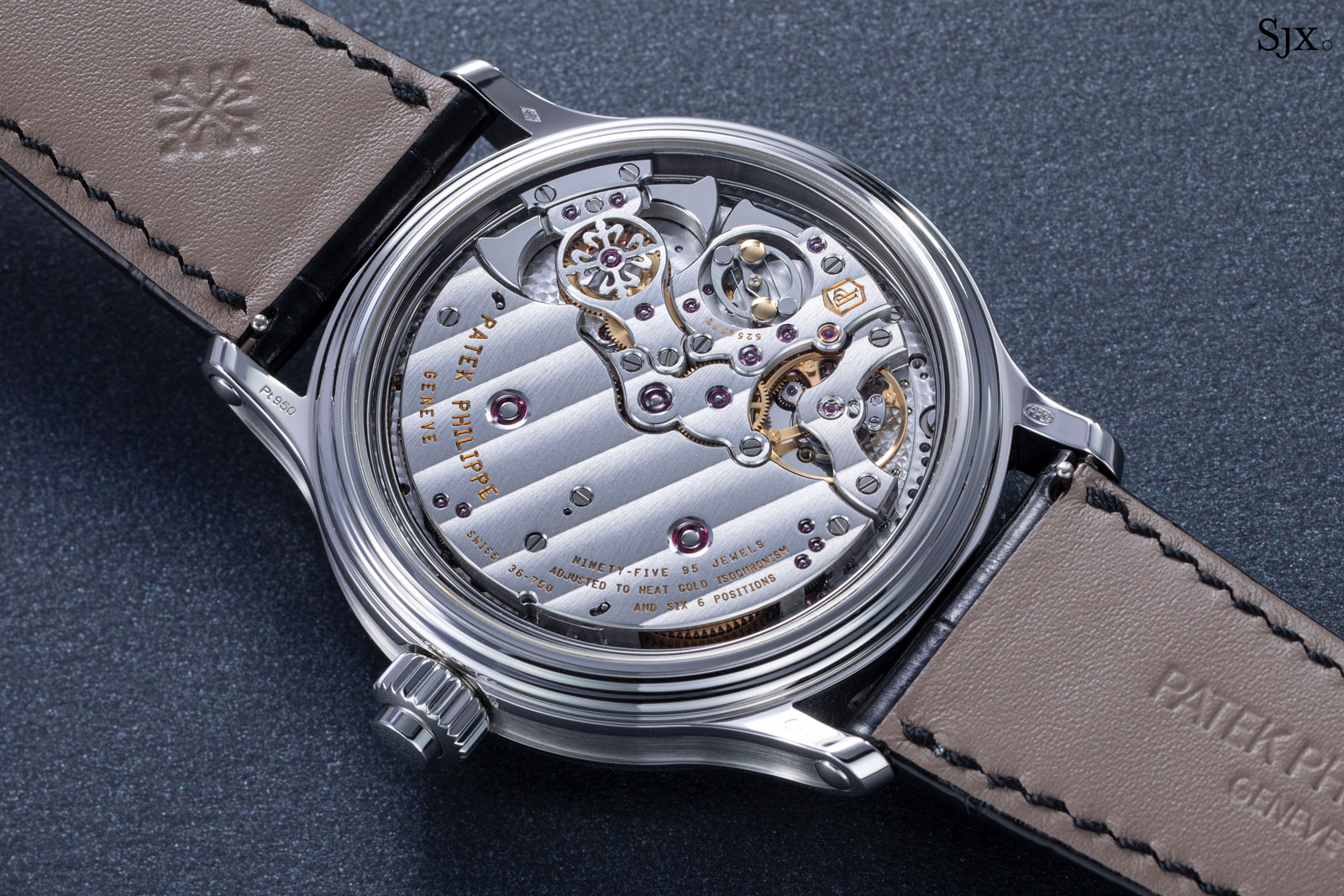
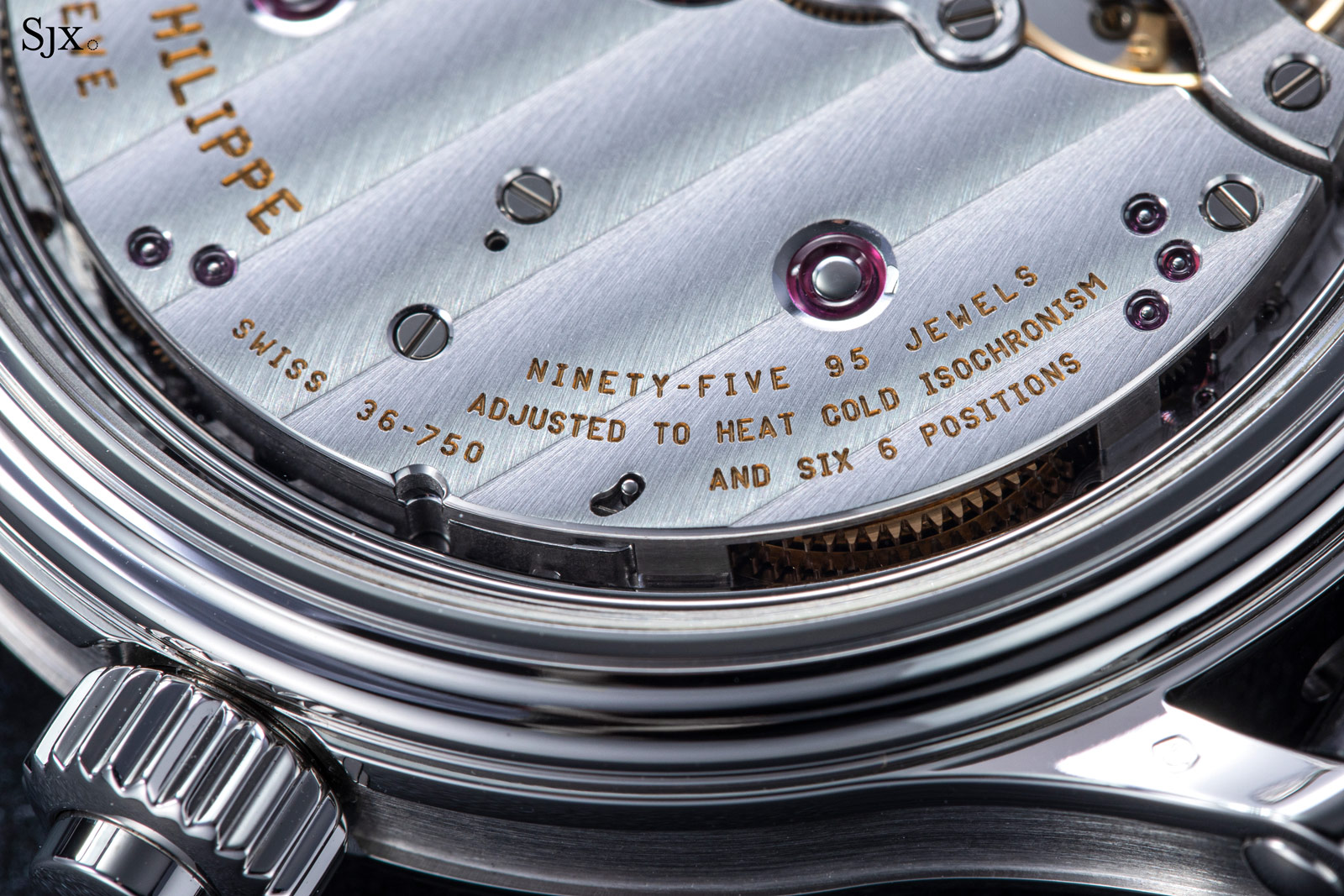
The barrel bridge with one mainspring pivot visible
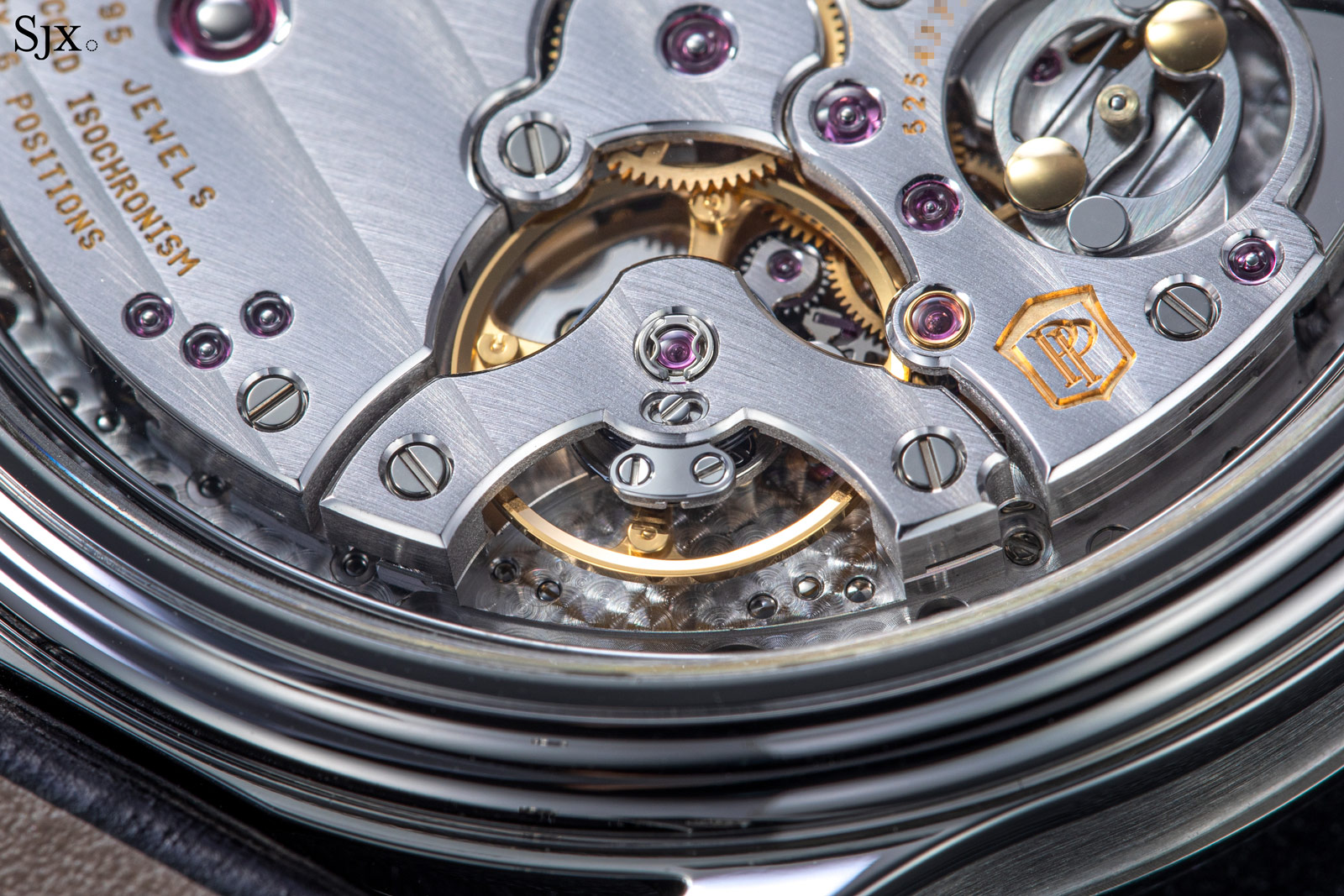
A symmetrical bridge secures the balance wheel
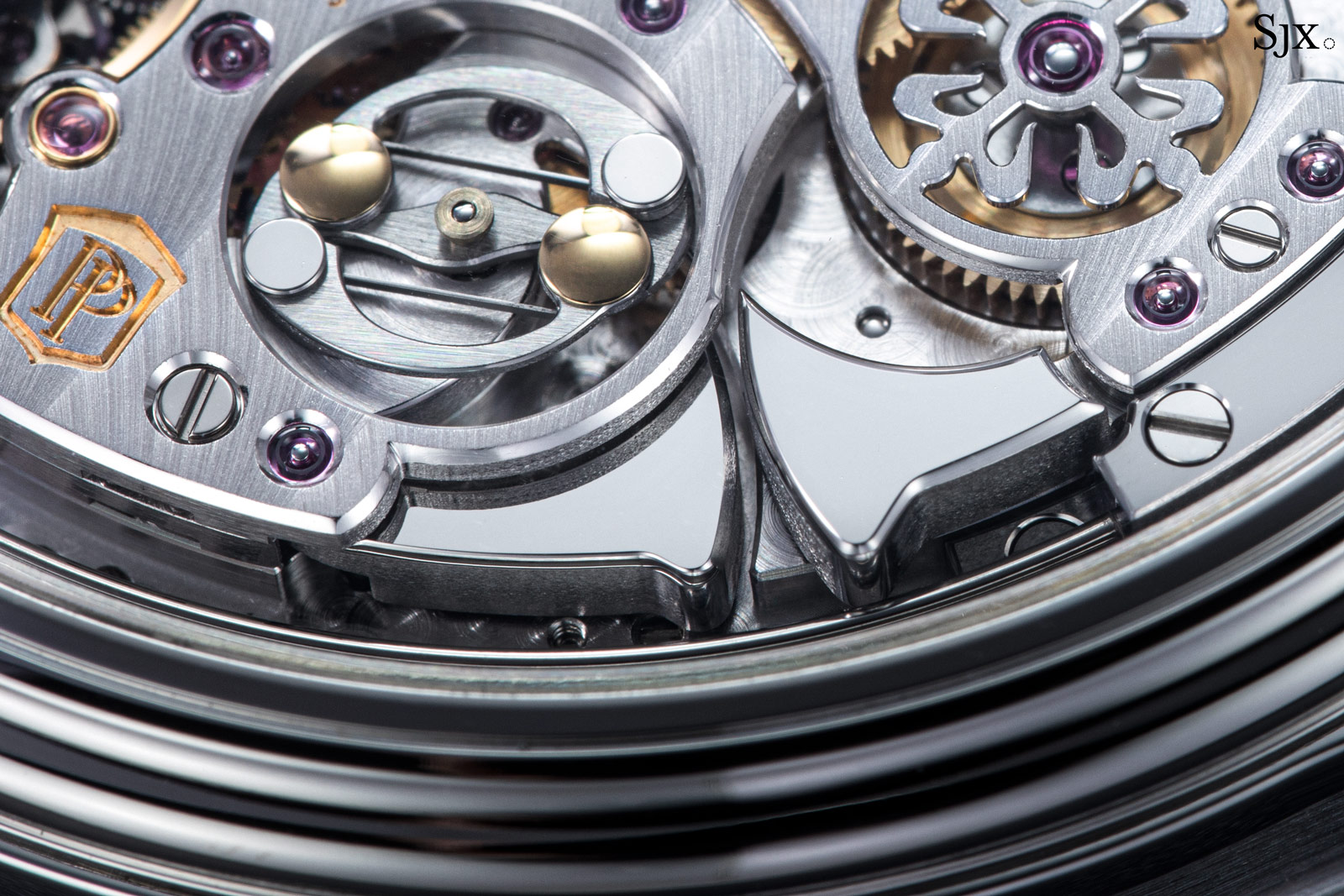
The governor sitting just above two of the three hammers
The decoration of the movement is very, very good. While some high-end Patek Philippe complicated movements feel like they could be decorated a bit better, this is outstanding.
To start with, all of the broad strokes are done well. The striping on the rhodium-plated bridges is lustrous and neat. At the same time, all of the bridges have wide, polished anglage on all edges.
In fact, the anglage, or chamfered edges, are notable for being numerous and also including numerous inward and outward angles, evidence that the final step in applying the anglage was done by hand.
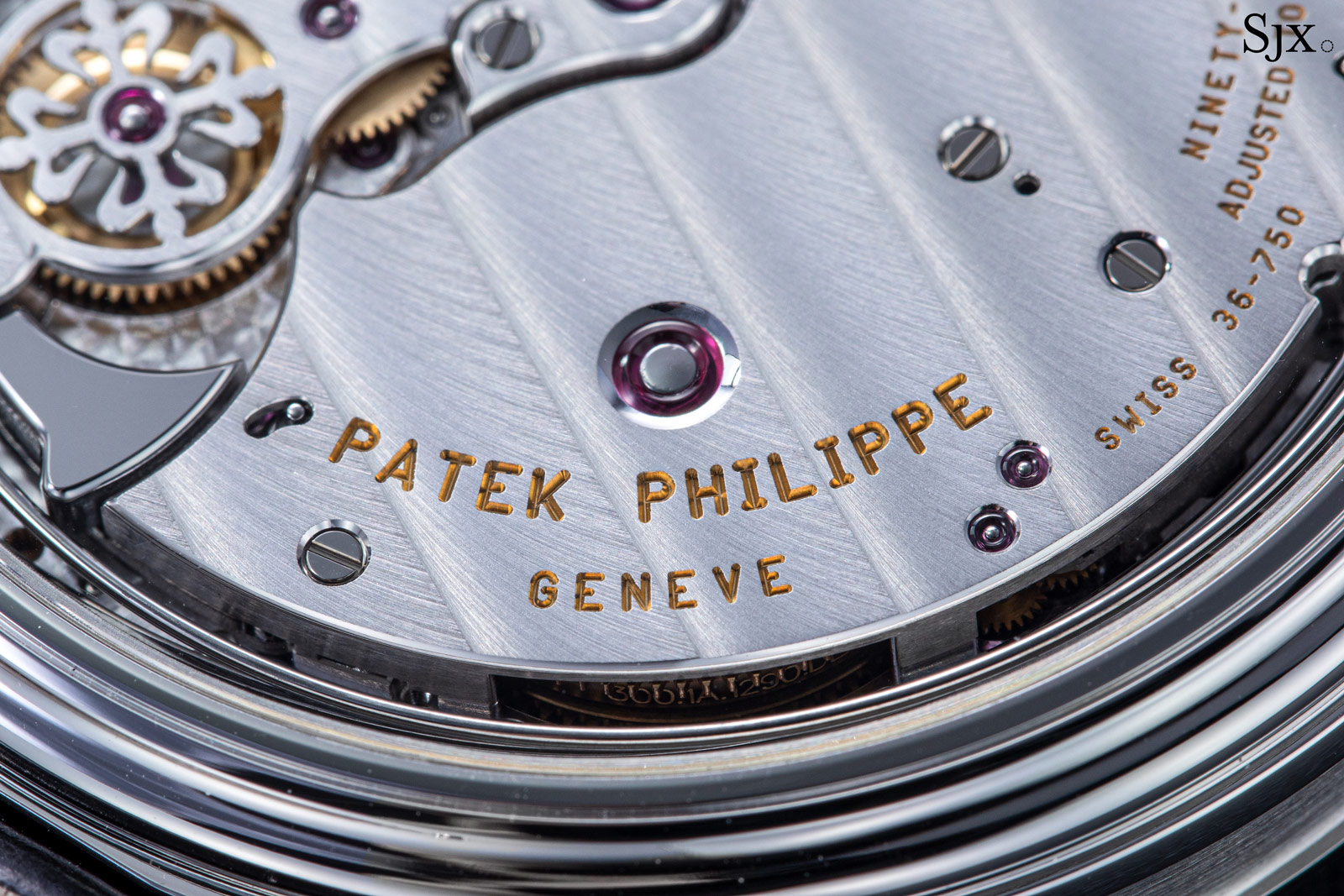
The jewel bearing for the mainspring pivots sits in a wide, bowl-shaped countersink that’s mirror polished
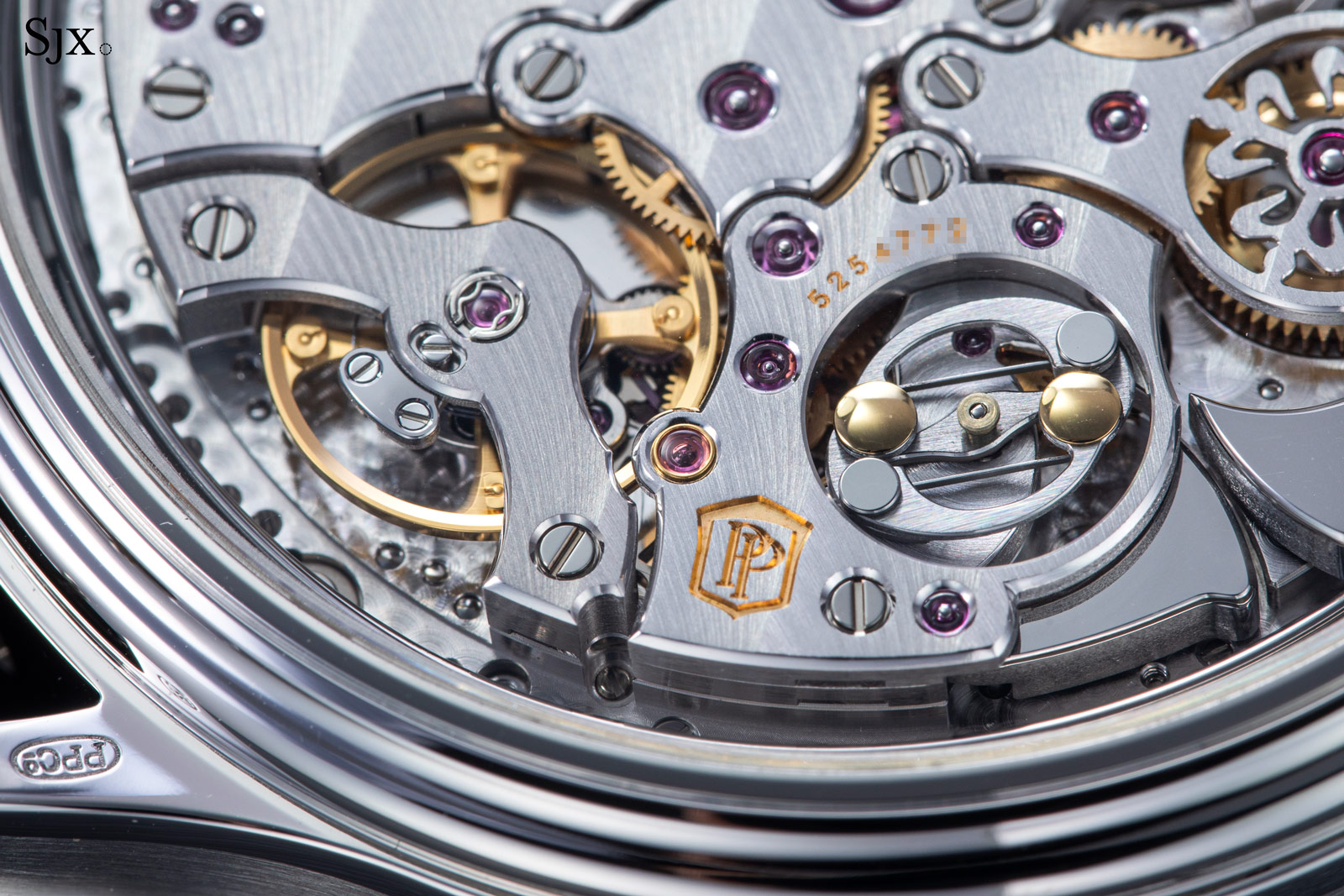
The balance bridge incorporates subtle details in its outline that accentuate its finishing
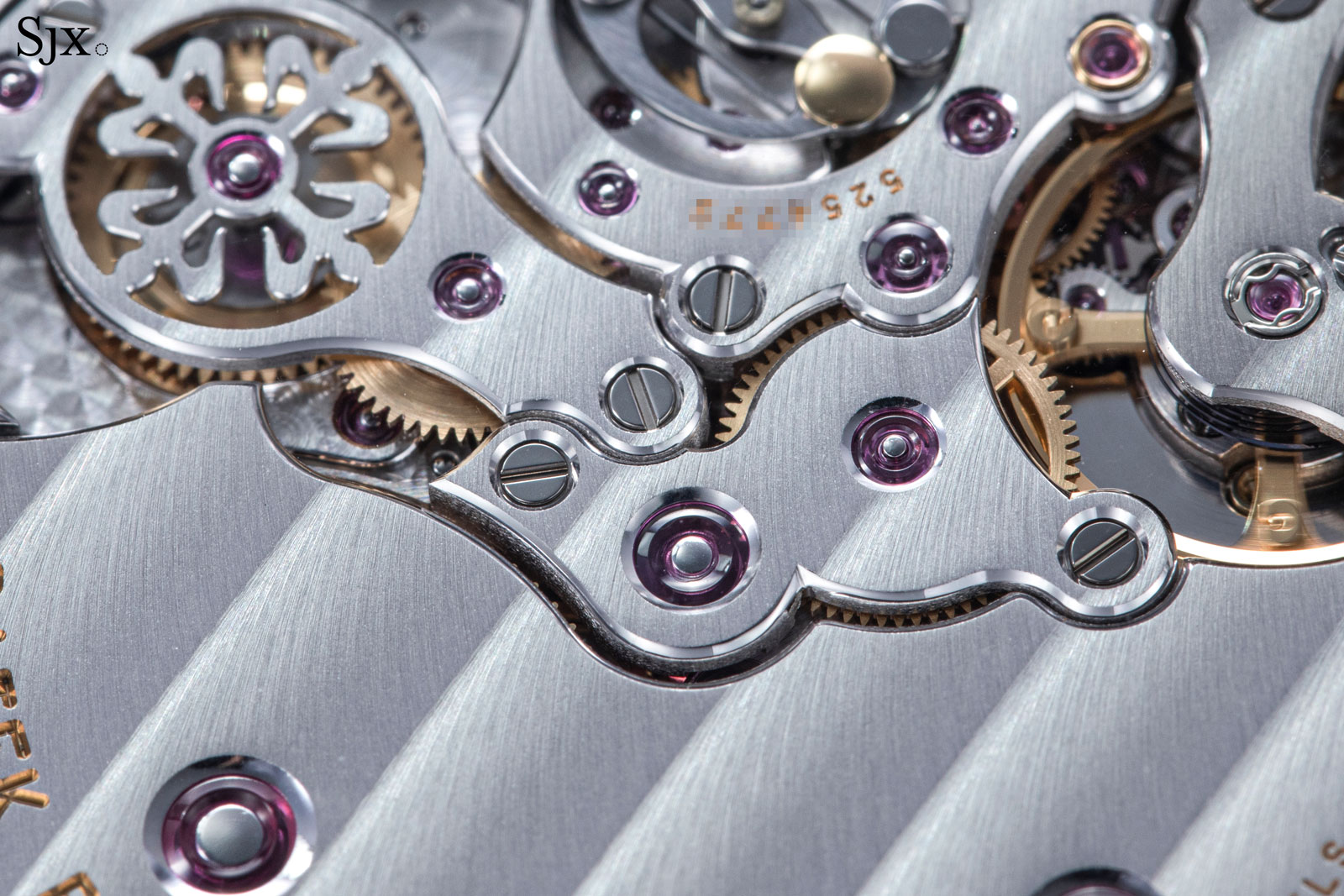
The smaller bridges boast a good number of inward and outward angles on their chamfered edges
The movement finishing is excellent enough that is continues to impress when under magnification. All parts, large and small, are properly attended to in a careful, refined manner. One of the movement’s best details is the varying size of the perlage on the base plate, with the diameter of each “spot” catered to the size of the recess.
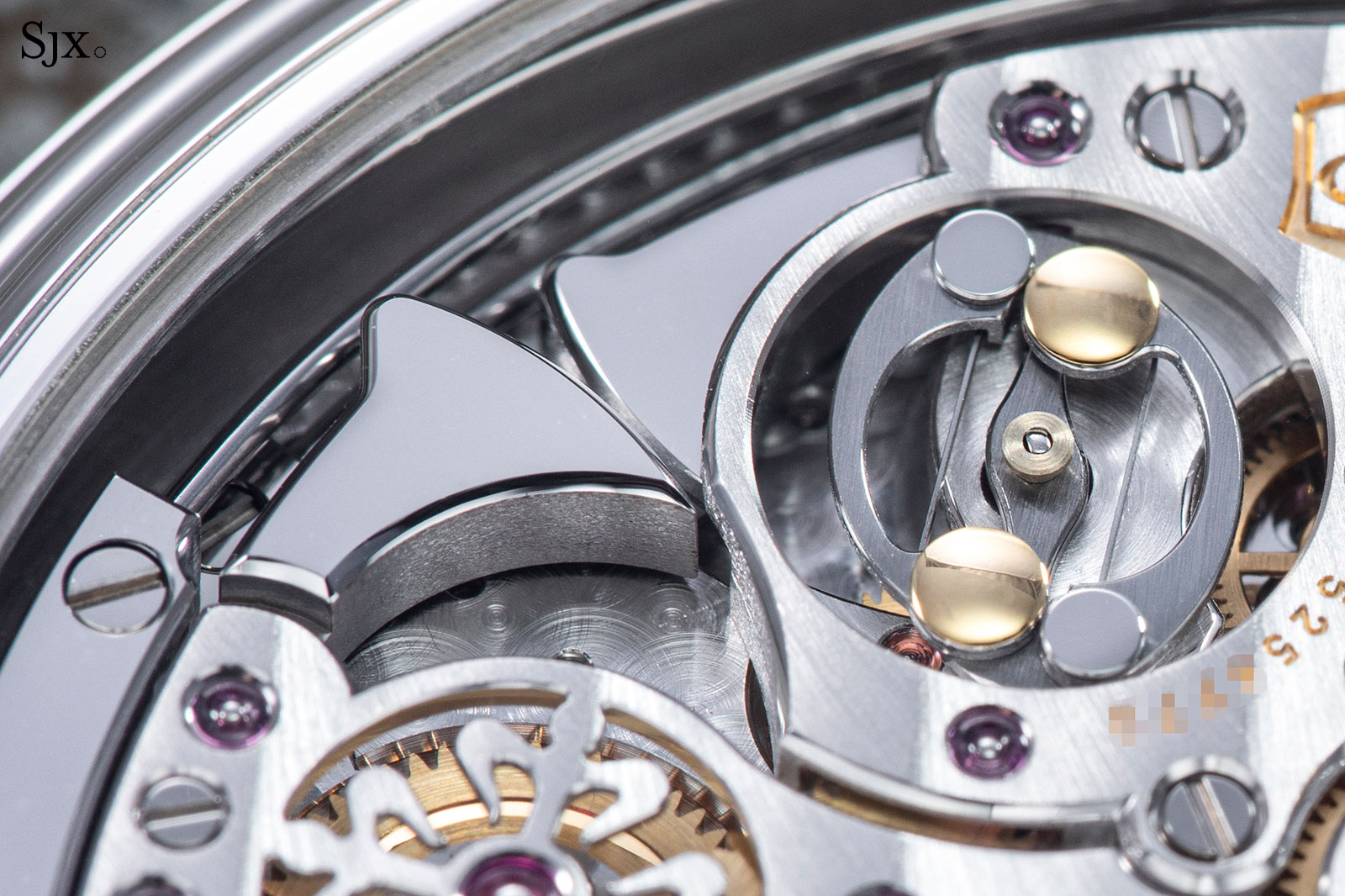
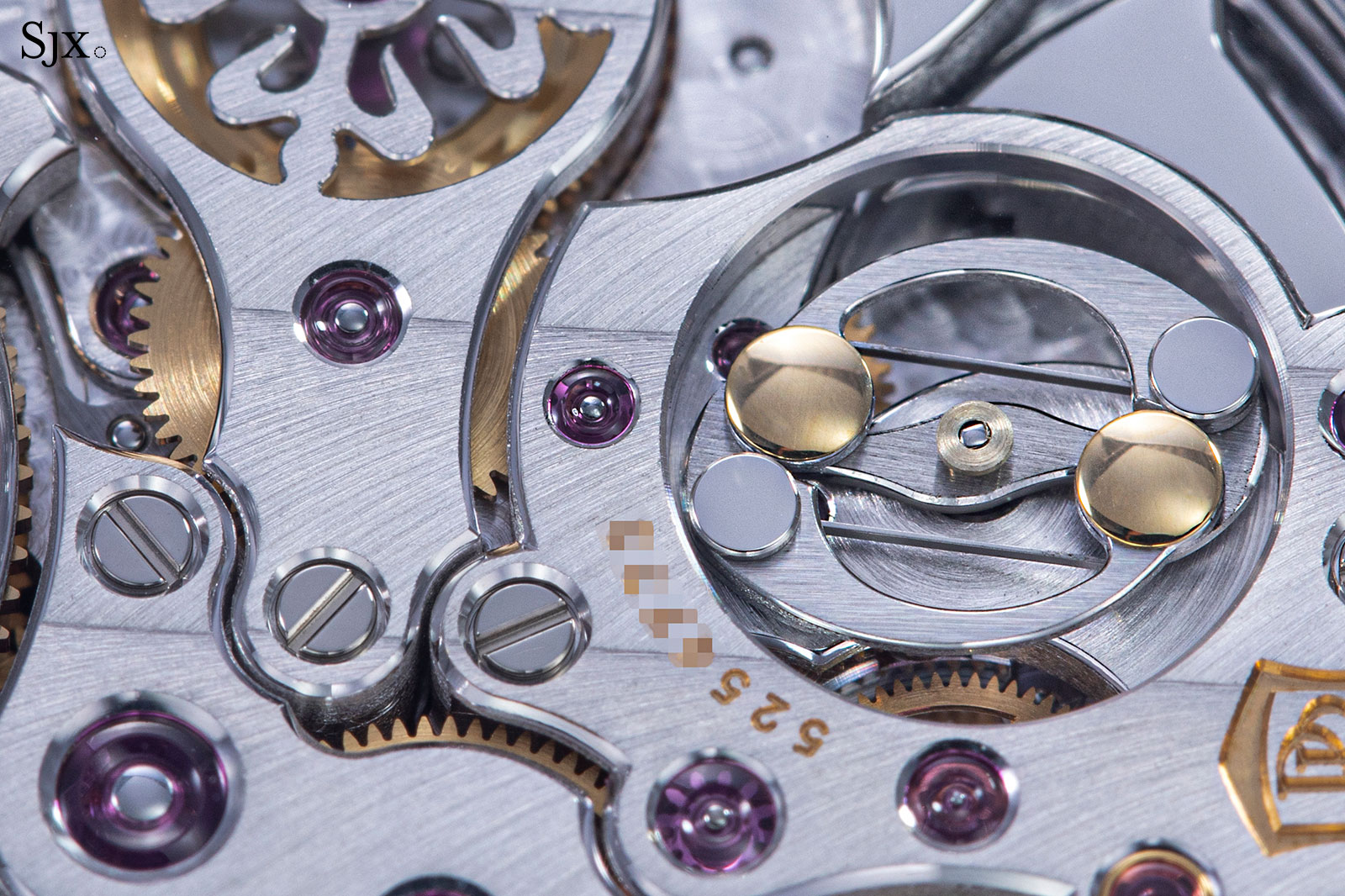
Even the extremely thin arms of the governor boast chamfered, polished edges
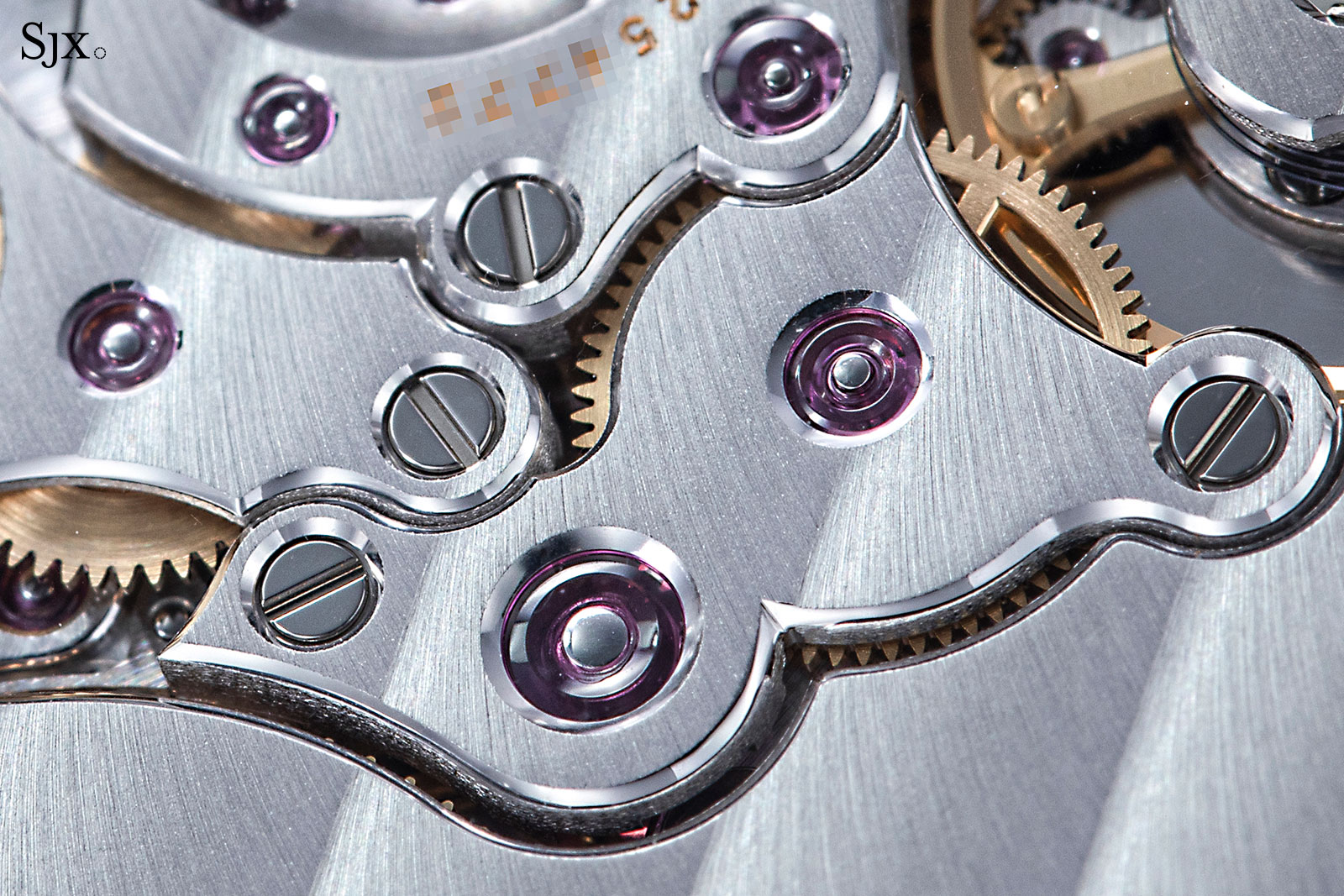
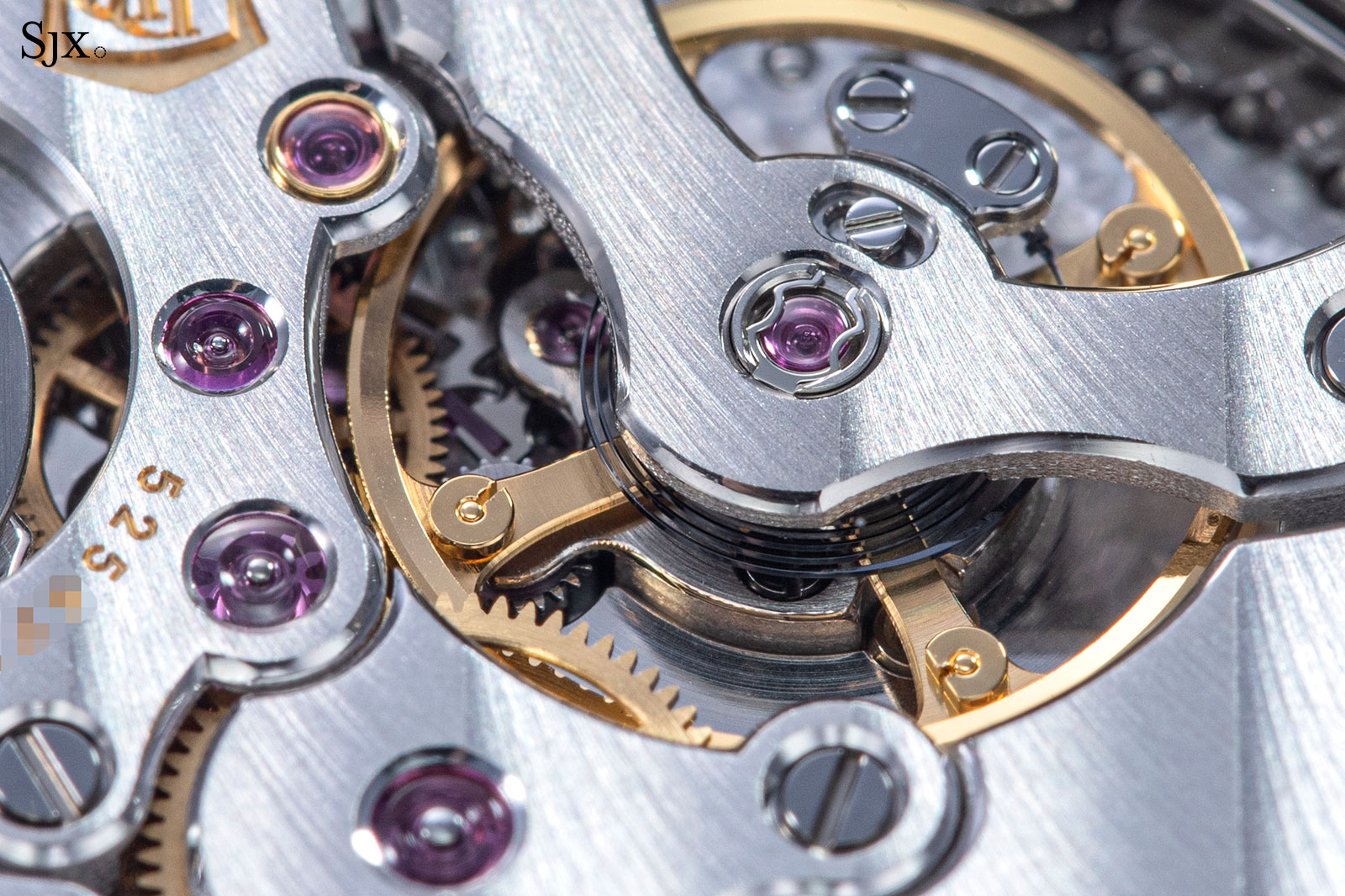
Sitting below the balance wheel, the bridge for the pallet lever features a narrow, but apparent, polished, bevelled edge
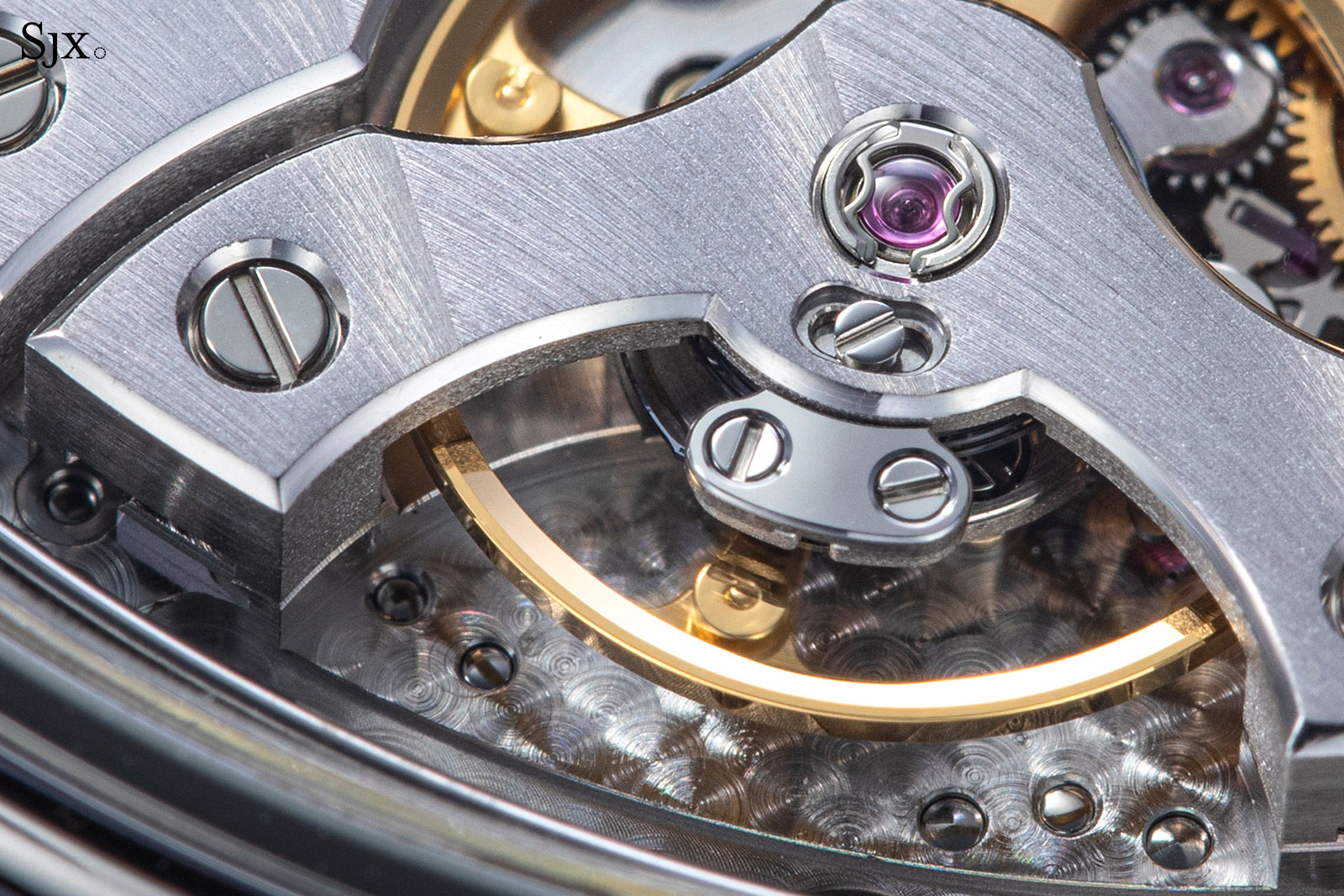
The perlage below the balance wheel is the smallest in scale
The finishing is good enough that it calls attention to two areas that lack hand-finished chamfered edges. One is the small aperture for the governor, and the other, the open-worked Calatrava cross. Both have edges that are clearly done by machine, with telltale milling marks visible.
But fortunately it is not a shortcoming, but a consequence of the size of the cross, which is small enough that it is near impossible to get the tool in place to polish the edges by hand.
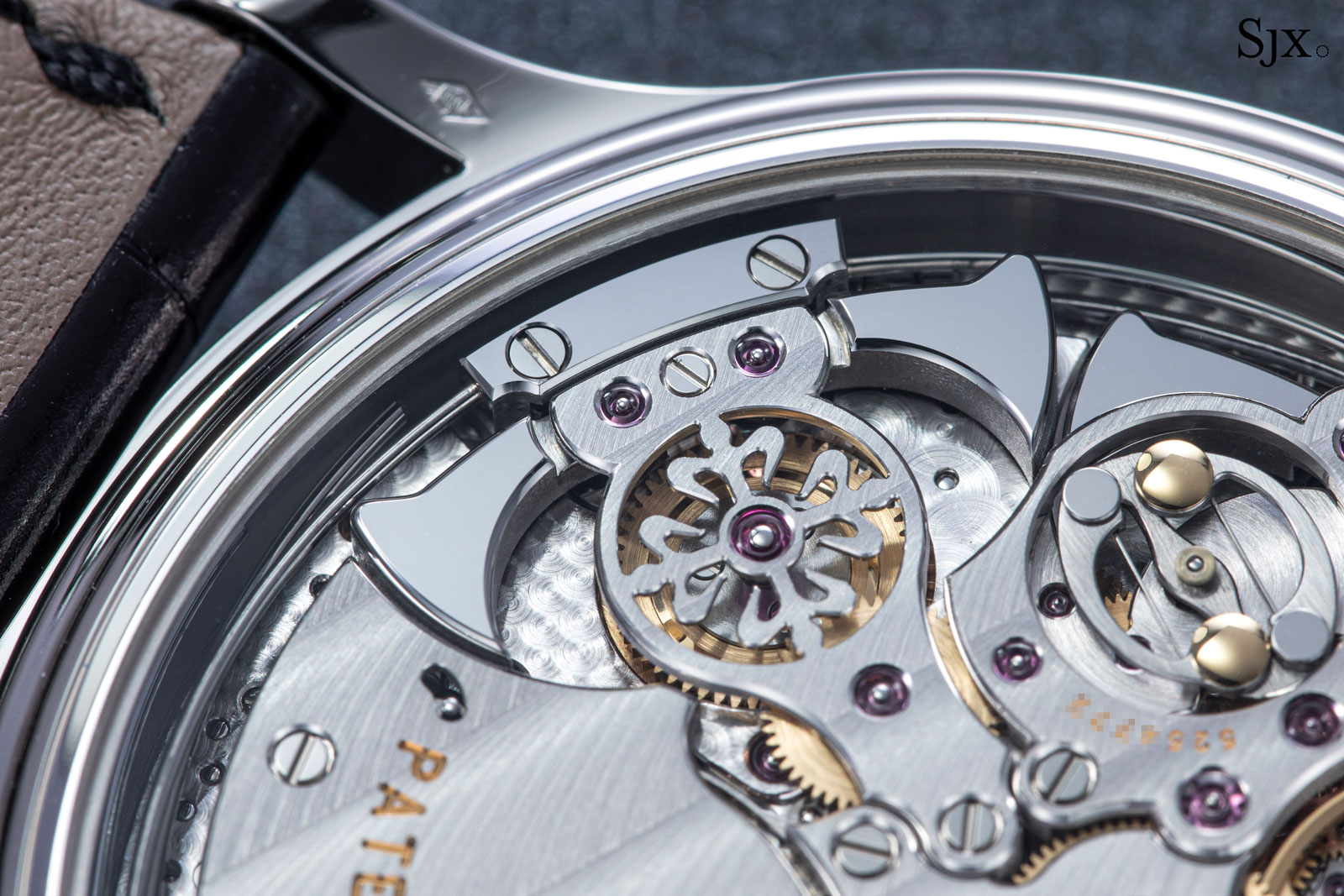
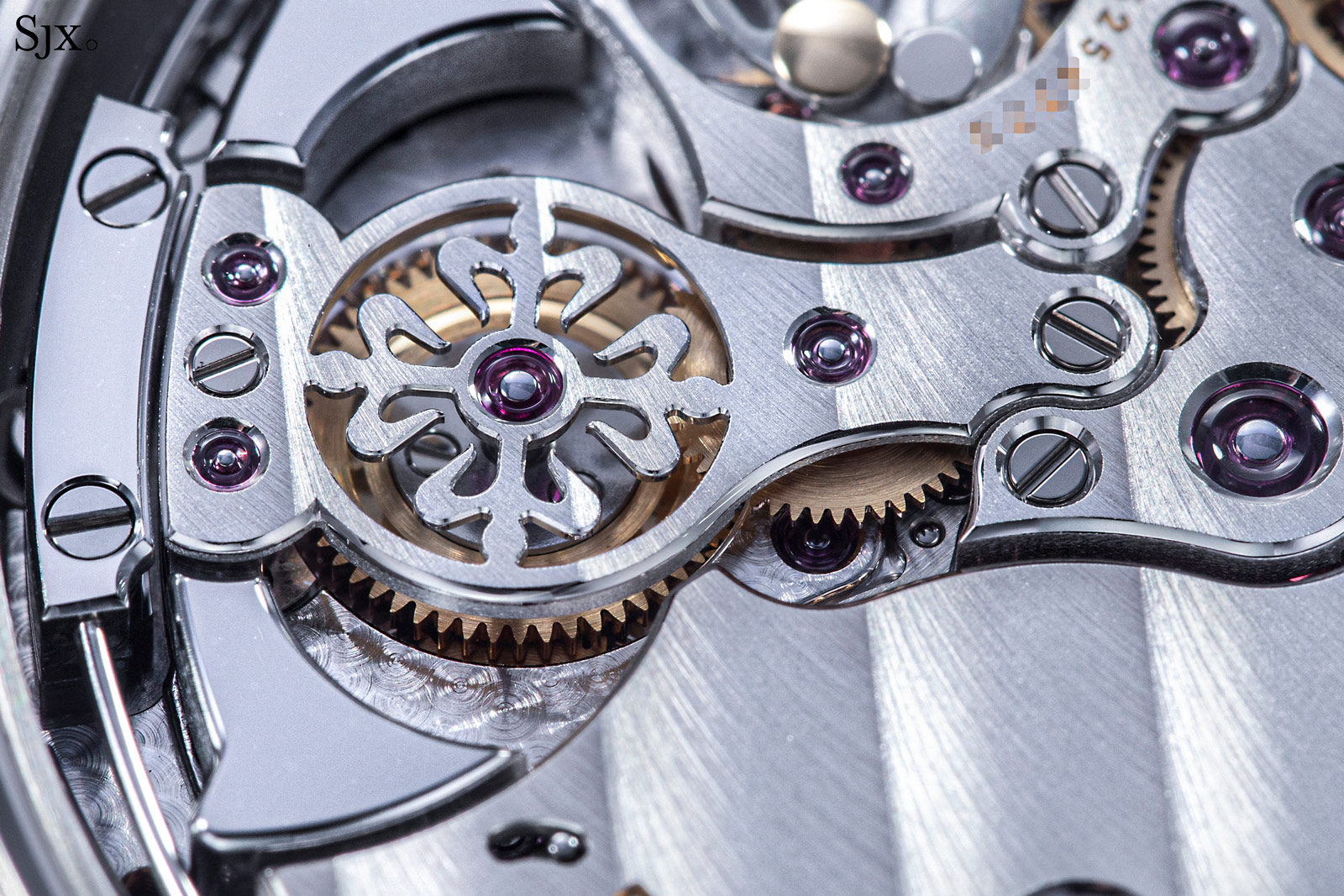
Concluding thoughts
The ref. 6301P is beautifully rendered in all aspects – design, finishing, construction, and sound. And it is a more compelling watch in its entirety compared to other grande sonnerie wristwatches. While other comparable watches outdo the ref. 6301P in one area, they fall short on another; the ref. 6301P does everything well.
And it actually a fair buy as million-dollar watches go. Though less complex, the ref. 6301P still boasts the chief complication of the Grandmaster Chime, which costs twice as much, or 30 times as much in the case of the one-off ref. 6300A “Only Watch”, which is the most expensive watch ever. From that perspective, the ref. 6301P isn’t a bad buy – no doubt an irrelevant verdict, since anyone who has both the coin and access to attain one already has, or soon will.
Key Facts and Price
Patek Philippe Grande Sonnerie
Ref. 6301P-001
Diameter: 44.8 mm
Height: 12 mm
Material: Platinum
Crystal: Sapphire
Water resistance: Moisture- and dust-resistant; not water resistant
Dial: Black enamel
Movement: GS 36-750 PS IRM
Functions: Hours, minutes, jumping seconds, power reserve indicators for both strikework and timekeeping barrels, grande and petite sonnerie carillon on three pairs gongs and hammers
Winding: Manual wind
Frequency: 25,200 beats per hour (3.5 Hz)
Power reserve: 72 hours for time, 24 hours for strikework
Strap: Alligator leather with folding clasp
Availability: From Patek Philippe Salons and authorised retailers
Price: 1.15 million Swiss francs including taxes, and 1.06 million francs without
For more information, visit Patek.com.
Back to top.

